Improve IT Governance to Drive Business Results

- IT governance is the number-one predictor of value generated by IT, yet many organizations struggle to organize their governance effectively.
- Current IT governance does not address the changing goals, risks, or context of the organization, so IT spend is not easily linked to value.
- The right people are not making the right decisions about IT.
Our Advice
Critical Insight
- Organizations do not have a governance framework in place that optimally aligns IT with the business objectives and direction.
- Implementing IT governance requires the involvement of key business stakeholders who do not see IT’s value in corporate governance and strategy.
- The current governance processes are poorly designed, making the time to decisions too long and driving non-compliance.
Impact and Result
- Use Info-Tech’s four-step process to optimize your IT governance framework.
- Our client-tested methodology supports the enablement of IT-business alignment, decreases decision-making cycle times, and increases IT’s transparency and effectiveness in decisions around benefits realization, risks, and resources.
- Successful completion of the IT governance redesign will result in the following outcomes:
- Align IT with the business context.
- Assess the current governance framework.
- Redesign the governance framework.
- Implement governance redesign.
Improve IT Governance to Drive Business Results Research & Tools
Start here – read the Executive Brief
Read our concise Executive Brief to find out why you should redesign IT governance, review Info-Tech’s methodology, and understand the four ways we can support you in completing this project.Besides the small introduction, subscribers and consulting clients within this management domain have access to:
- Improve IT Governance to Drive Business Results – Phases 1-4
1. Align IT with the business context
Align IT’s direction with the business using the Statement of Business Context.
- Redesign IT Governance to Drive Optimal Business Results – Phase 1: Align IT With the Business Context
- Make the Case for an IT Governance Redesign
- Stakeholder Power Map Template
- IT Governance Stakeholder Communication Planning Tool
- PESTLE Analysis Template
- Business SWOT Analysis Template
- Statement of Business Context Template
2. Assess the current governance framework
Evaluate the strengths and weaknesses of current governance using the Current State Assessment.
- Redesign IT Governance to Drive Optimal Business Results – Phase 2: Assess the Current Governance Framework
- Current State Assessment of IT Governance
3. Redesign the governance framework
Build a redesign of the governance framework using the Future State Design template.
- Redesign IT Governance to Drive Optimal Business Results – Phase 3: Redesign the Governance Framework
- Future State Design for IT Governance
- IT Governance Terms of Reference
4. Implement governance redesign
Create an implementation plan to jump-start the communication of the redesign and set it up for success.
- Redesign IT Governance to Drive Optimal Business Results – Phase 4: Implement Governance Redesign
- Redesign IT Governance to Drive Optimal Business Results Executive Presentation Template
- IT Governance Implementation Plan
Workshop: Improve IT Governance to Drive Business Results
Workshops offer an easy way to accelerate your project. If you are unable to do the project yourself, and a Guided Implementation isn't enough, we offer low-cost delivery of our project workshops. We take you through every phase of your project and ensure that you have a roadmap in place to complete your project successfully.
1 Identify the Need for Governance
The Purpose
Identify the need for governance in your organization and engage the leadership team in the redesign process.
Key Benefits Achieved
Establish an engagement standard for the leadership of your organization in the IT governance redesign.
Activities
1.1 Identify stakeholders.
1.2 Make the case for improved IT governance.
1.3 Customize communication plan.
Outputs
Stakeholder Power Map
Make the Case Presentation
Communication Plan
2 Align IT With the Business Context
The Purpose
Create a mutual understanding with the business leaders of the current state of the organization and the state of business it is moving towards.
Key Benefits Achieved
The understanding of the business context will provide an aligned foundation on which to redesign the IT governance framework.
Activities
2.1 Review documents.
2.2 Analyze frameworks.
2.3 Conduct brainstorming.
2.4 Finalize the Statement of Business Context.
Outputs
PESTLE Analysis
SWOT Analysis
Statement of Business Context
3 Assess the Current Governance Framework
The Purpose
Establish a baseline of the current governance framework.
Key Benefits Achieved
Develop guidelines based off results from the current state that will guide the future state design.
Activities
3.1 Create committee profiles.
3.2 Build governance structure map.
3.3 Establish governance guidelines.
Outputs
Current State Assessment
4 Redesign the Governance Framework
The Purpose
Redesign the governance structure and the committees that operate within it.
Key Benefits Achieved
Build a future state of governance where the relationships and processes that are built drive optimal business results.
Activities
4.1 Build governance structure map.
4.2 Create committee profiles.
Outputs
Future State Design
IT Governance Terms of Reference
5 Implement Governance Redesign
The Purpose
Build a roadmap for implementing the governance redesign.
Key Benefits Achieved
Create a transparent and relationship-oriented implementation strategy that will pave the way for a successful redesign implementation.
Activities
5.1 Identify next steps for the redesign.
5.2 Establish communication plan.
5.3 Lead executive presentation.
Outputs
Implementation Plan
Executive Presentation
Further reading
Improve IT Governance to Drive Business Results
Avoid bureaucracy and achieve alignment with a minimalist approach.
ANALYST PERSPECTIVE
Governance optimization is achieved where decision making, authority, and context meet.
"Governance is something that is done externally to IT and well as internally by IT, with the intention of providing oversight to direct the organization to meet goals and keep things on target.
Optimizing IT governance is the most effective way to consistently direct IT spend to areas that provide the most value in producing or supporting business outcomes, yet it is rarely done well.
IT governance is more than just identifying where decisions are made and who has the authority to make them – it must also provide the context and criteria under which decisions are made in order to truly provide business value" (Valence Howden, Director, CIO Practice Info-Tech Research Group)
Our understanding of the problem
This Research is Designed For:
- CIOs
- CTOs
- IT Directors
This Research Will Help You:
- Achieve and maintain executive and business support for optimizing IT governance.
- Optimize your governance structure.
- Build high-level governance processes.
- Build governance committee charters and set accountability for decision making.
- Plan the transition to the optimized governance structure and processes.
This Research Will Also Assist:
- Executive Leadership
- IT Managers
- IT Customers
- Project Managers
This Research Will Help Them:
- Improve alignment between business decisions and IT initiatives.
- Establish a mechanism to validate, redirect, and reprioritize IT initiatives.
- Realize greater value from more effective decision making.
- Receive a better overall quality of service.
Executive Summary
Situation
- IT governance is the #1 predictor of value generated by IT, yet many organizations struggle to organize their governance effectively.*
- Current IT governance does not address the changing goals, risks, or context of the organization so IT spend is not easily linked to value.
- The right people are not making the right decisions about IT.
Complication
- Organizations do not have a governance framework in place that optimally aligns IT with the business objectives and direction.
- Implementing IT governance requires the involvement of key business stakeholders who do not see IT’s value in governance and strategy.
- The current governance processes are poorly designed, creating long decision-making cycles and driving non-compliance with regulation.
Resolution
- Use Info-Tech’s four-step process for optimizing your IT governance framework. Our client-tested methodology supports the enablement of IT-business alignment, decreases decision-making cycle times, and increases IT’s transparency and effectiveness in making decisions around benefits realization, risks, and resources.
- Successful completion of the IT governance redesign will result in the following outcomes:
- Align IT with the business context.
- Assess the current governance framework.
- Redesign the governance framework.
- Implement governance redesign.
Info-Tech Insight
- Establish IT-business fusion. In governance, alignment is not enough. Merge IT and the business through governance to ensure business success.
- With great governance comes great responsibility. Involve relevant business leaders, who will be impacted by IT outcomes, to take on governing responsibility of IT.
- Let IT manage and the business govern. IT governance should be a component of enterprise governance, allowing IT leaders to focus on managing.
IT governance is...
An enabling framework for decision-making context and accountabilities for related processes.
A means of ensuring business-IT collaboration, leading to increased consistency and transparency in decision making and prioritization of initiatives.
A critical component of ensuring delivery of business value from IT spend and driving high satisfaction with IT.
IT governance is not...
An annoying, finger-waving roadblock in the way of getting things done.
Limited to making decisions about technology.
Designed tacitly; it is purposeful, with business objectives in mind.
A one-time project; you must review and revalidate the efficiency.
Avoid common misconceptions of IT governance
Don’t blur the lines between governance and management; each has a unique role to play. Confusing these results in wasted time and confusion around ownership.
Governance |
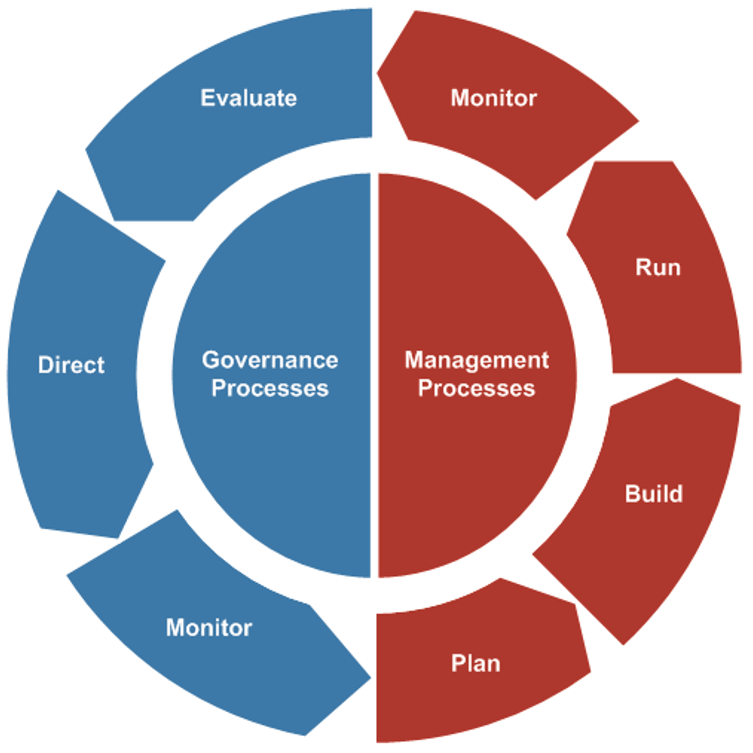 |
Management |
IT governance sets direction through prioritization and decision making, and monitors overall IT performance. Governance aligns with the mission and vision of the organization to guide IT. |
Management is responsible for executing on, operating, and monitoring activities as determined by IT governance. Management makes decisions for implementing based on governance direction. |
The IT Governance Framework
An IT governance framework is a system that will design structures, processes, authority definitions, and membership assignments that lead IT toward optimal results for the business.
Governance is performed in three ways:
Evaluate
Governance ensures that business goals are achieved by evaluating stakeholder needs, criteria, metrics, portfolio, risk, and definition of value.Direct
Governance sets the direction of IT by delegating priorities and determining the decisions that will guide the IT organization.Monitor
Governance establishes a framework to monitor performance, compliance to regulation, and progress on expected outcomes.
"Everyone needs good IT, but no one wants to talk about it. Most CFOs would rather spend time with their in-laws than in an IT steering-committee meeting. But companies with good governance consistently outperform companies with bad. Which group do you want to be in?" (Martha Heller, President, Heller Search Associates)
Create impactful IT governance by embedding it within enterprise governance
The business should engage in IT governance and IT should influence the direction of the business.
Enterprise Governance |
IT Governance |
|
Authority for enterprise governance falls to the board and executive management. Responsibilities Include:
|
–› Engage in –› ‹– Influence ‹– |
Governance of IT is a component of enterprise governance. Responsibilities Include:
|
Identify signals of sub-optimal IT governance within any of these domains
If you notice any of these signals, governance redesign is right for you!
Inability to Realize Benefits
- IT is unable to articulate the value of its initiatives or spend.
- IT is regularly delegated unplanned projects.
- The is no standard approach to prioritization.
- Projects do not meet target metrics.
Resource Misallocation
- Resources are wasted due to duplication or overlap in IT initiatives.
- IT projects fail at an unacceptable rate, leading to wasted resources.
- IT’s costs continue to increase without reciprocal performance increase.
Misdiagnosed Risks
- Risk appetite is incorrectly identified or not identified at all.
- Disagreement on the approach to risk in the organization.
- Increasing rate of IT incidents related to risk.
- IT is failing to meet regulatory requirements.
Dissatisfied Stakeholders
- There are no ways to measure stakeholder satisfaction with IT.
- Business strategies and IT strategies are misaligned.
- IT’s relationship with key stakeholders is unstable and there is a lack of mutual trust.
A majority of organizations experience significant alignment gaps
The majority of organizations and their key stakeholders experience highly visible gaps in the alignment of IT investments and organizational goals.
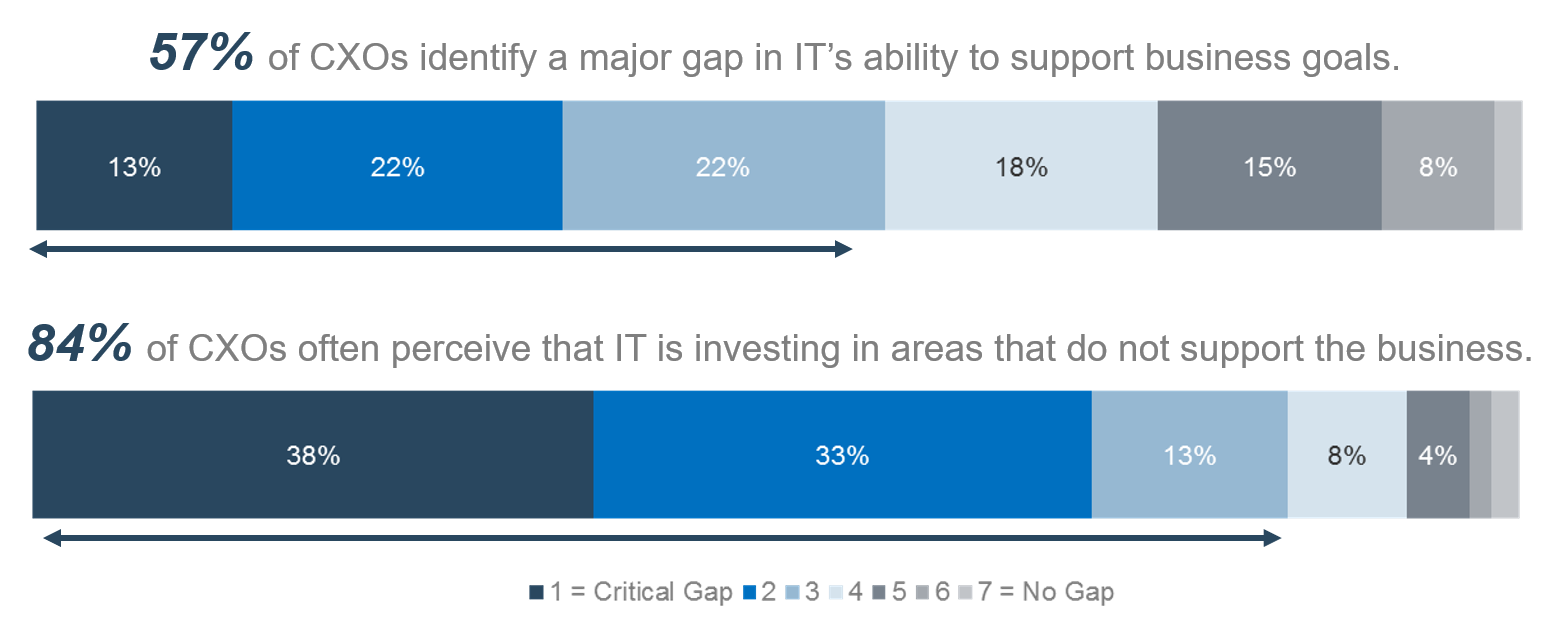
88% of CIOs believe that their governance is not effective. (Info-Tech Diagnostics)
Leverage governance as the catalyst for connecting IT and the business
49% of firms are misaligned on current performance expectations for IT.
- 49% Misaligned
- 51% Aligned
67% of firms are misaligned on the target role for IT.
- 34% Highly Misaligned
- 33% Somewhat Misaligned
- 33% Aligned
A well-designed IT governance framework will hep you to:
- Make sure IT keeps up with the evolving business context.
- Align IT with the mission and the vision of the organization.
- Optimize the speed and quality of decision making.
- Meet regulatory and compliance needs in the external environment. (Info-Tech Diagnostics)
Align with business goals through governance to attain business-IT fusion
Create a state of business-IT fusion, in which the two become one.
Without business-IT fusion, IT will go in a different direction, leading to a divergence of purpose and outcomes. IT can transform into a fused partner of the business by ensuring that they govern toward the same goal.
Firefighter
|
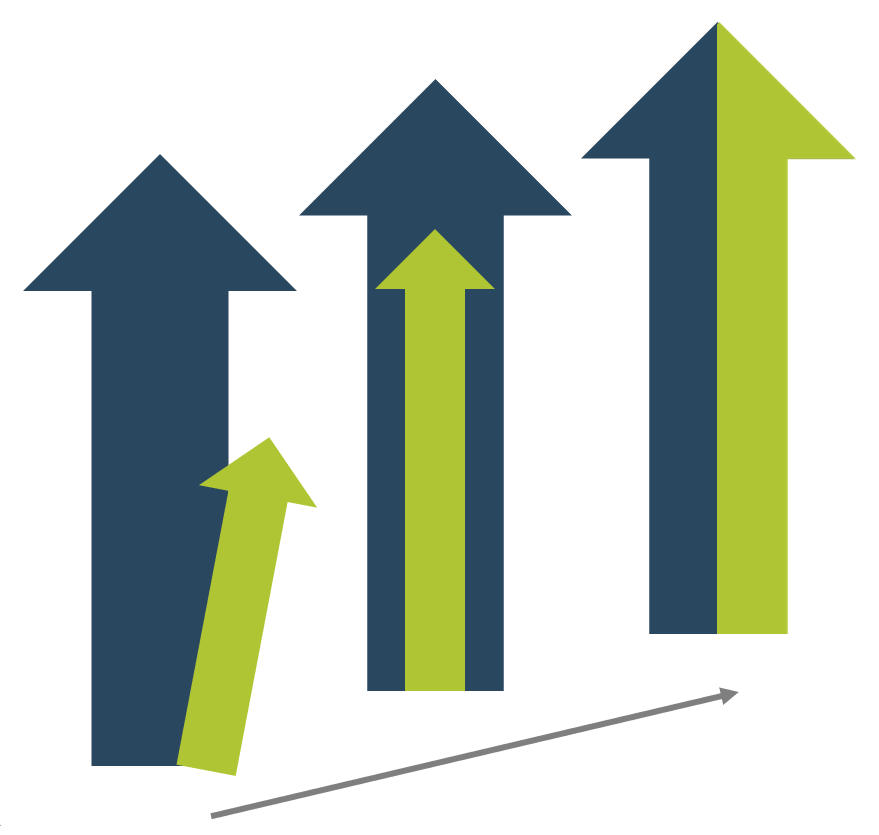 |
Business Partner
|
Redesign IT governance in accordance with COBIT and proven good practice
Info-Tech’s approach to governance redesign is rooted in COBIT, the world-class and open-source IT governance standard.
COBIT begins with governance, EDM – Evaluate, Direct, and Monitor.
We build upon these standards with industry best practices and add a practical approach based on member feedback.
This blueprint will help you optimize your governance framework.
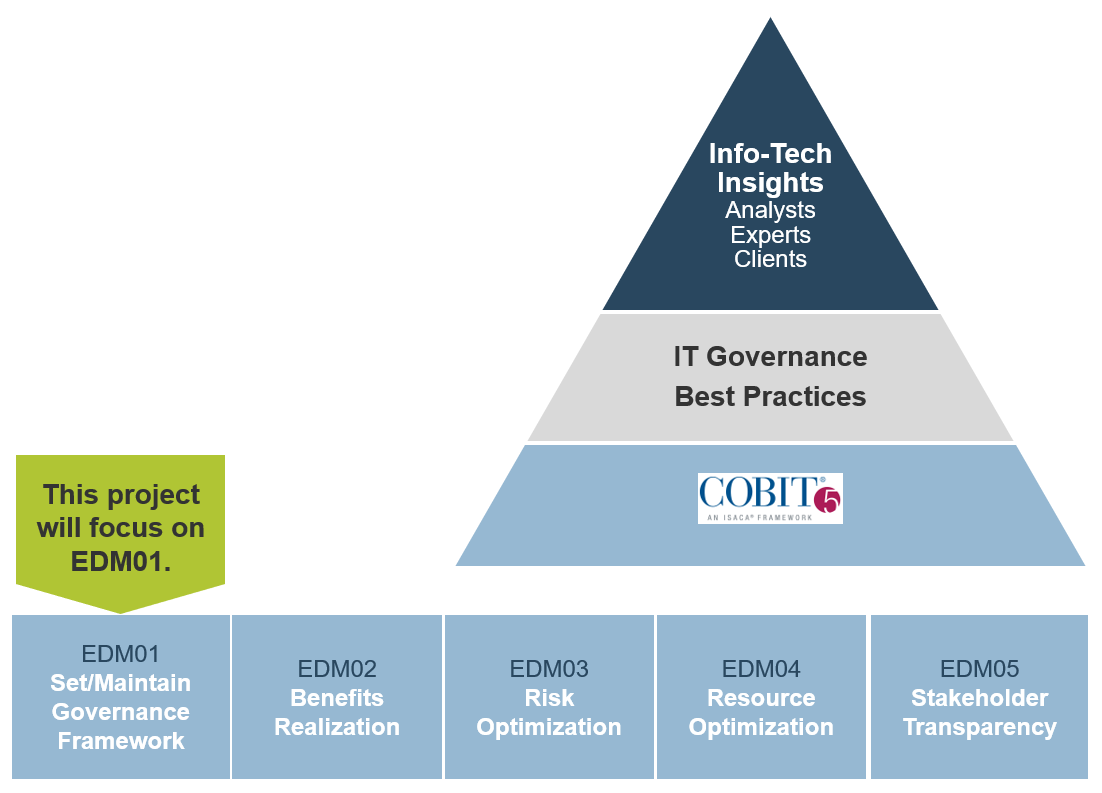
Use Info-Tech’s approach to implementing an IT governance redesign
The four phases of Info-Tech’s governance redesign methodology will help you drive greater value for the business.
- Align IT With the Business Context
Align IT’s direction with the business using the Statement of Business Context Template. - Assess the Current Governance Framework
Evaluate the strengths and weaknesses of current governance using the Current State Assessment of IT Governance. - Redesign the Governance Framework
Build a redesign of the governance framework using the Future State Design for IT Governance tool. - Implement Governance Redesign
Create an IT Governance Implementation Plan to jumpstart the communication of the redesign and set it up for success.
Continuously assess your governance framework to ensure alignment.
Leverage Info-Tech’s insights for an optimal redesign process
Common Pitfalls |
Info-Tech Solutions |
||
Phase 1 |
There must be an active understanding of the current and future state of the business for governance to address the changing needs of the business. | –› |
|
Phase 2 |
Take a proactive approach to revising your governance framework. Understand why you are making decisions before actually making them. | –› |
|
Phase 3 |
Keep the current and future goals in sight to build an optimized governance framework that maintains the minimum bar of oversight required. | –› |
|
Phase 4 |
Don’t overlook the politics and culture of your organization in redesigning your governance framework. | –› |
|
Leverage both COBIT and Info-Tech-defined metrics to evaluate the success of your redesign
These metrics will help you determine the extent to which your governance is supporting your business goals, and whether the governance in place promotes business-IT fusion.
Benefits Realization
- Percent of IT-enabled investments where benefit realization is monitored through the full economic life. (COBIT-defined metric)
- Percent of enterprise strategic goals and requirements supported by IT strategic goals. (COBIT-defined metric)
- Percent of IT services where expected benefits are realized or exceeded. (COBIT-defined metric)
Resources
- Satisfaction level of business and IT executives with IT-related costs and capabilities. (COBIT-defined metric)
- Average time to turn strategic IT objectives into an agreed-upon and approved initiative. (COBIT-defined metric)
- Number of deviations from resource utilization plan.
Risks
- Number of security incidents causing financial loss, business disruption, or public embarrassment. (COBIT-defined metric)
- Number of issues related to non-compliance with policies. (COBIT-defined metric)
- Percentage of enterprise risk assessments that include IT-related risks. (COBIT-defined metric)
- Frequency with which the risk profile is updated. (COBIT-defined metric)
Stakeholders
- Change in score of alignment with the scope of the planned portfolio of programs and services (using CIO-CXO Alignment Diagnostic).
- Percent of executive management roles with clearly defined accountabilities for IT decisions. (COBIT-defined metric)
- Percent of business stakeholders satisfied that IT service delivery meets agreed-upon service levels. (COBIT-defined metric)
- Percent of key business stakeholders involved in IT governance.
Capture monetary value by establishing and monitoring key metrics
While benefits of governance are often qualitative, the power of effective governance can be demonstrated through quantitative financial gains.
Scenario 1 – Realizing Expected Gains |
Scenario 2 – Mitigating Unexpected Losses |
|
Metric |
Track the percentage of initiatives that provided expected ROI year over year. The optimization of the governance framework should generate an increase in this metric. Monitor this metric for continuous improvement opportunities. | Track the financial losses related to non-compliance with policy or regulation. An optimized governance framework should better protect the organization against policy breach and mitigate the possibility and impact of “rogue” actions. |
Formula |
ROI of all initiatives / number of initiatives in year 2 – ROI of all initiatives / number of initiatives in year 1
The expected result should be positive. |
Cost of non-compliance in year 2 – cost of non-compliance in year 1
The expected result should be negative. |
Redesign IT governance to achieve optimal business outcomes
CASE STUDY
Industry: Healthcare
Source: Info-Tech
Situation
The IT governance had been structured based on regulations and had not changed much since it was put in place. However, a move to become an integration and service focused organization had moved the organization into the world of web services, Agile development, and service-oriented architecture.
Complication
The existing process was well defined and entrenched, but did not enable rapid decision making and Agile service delivery. This was due to the number of committees where initiatives were reviewed, made worse by their lack of approval authority. This led to issues moving initiatives forward in the timeframes required to meet clinician needs and committed governmental deadlines.
In addition, the revised organizational mandate had created confusion regarding the primary purpose and function of the organization and impacted the ability to prioritize spend on a limited budget.
To complicate matters further, there was political sensitivity tied to the membership and authority of different governing committees.
Result:
The CEO decided that a project would be initiated by the Enterprise Architecture Group, but managed by an external consultant to optimize and restructure the governance within the organization.
The purpose of using the external consultant was to help remove internal politics from the discussion. This allowed the organization to establish a shared view of the organization’s revised mission and IT’s role in its execution.
The exercise led to the removal of one governing committee and the merger of two others, modification to committee authority and membership, and a refined decision-making context that was agreed to by all parties.
The redesigned governance process led to a 30% reduction in cycle time from intake to decision, and a 15% improvement in alignment of IT spend with strategic priorities.
Use these icons to help direct you as you navigate this research
Use these icons to help guide you through each step of the blueprint and direct you to content related to the recommended activities.

This icon denotes a slide where a supporting Info-Tech tool or template will help you perform the activity or step associated with the slide. Refer to the supporting tool or template to get the best results and proceed to the next step of the project.

This icon denotes a slide with an associated activity. The activity can be performed either as part of your project or with the support of Info-Tech team members, who will come onsite to facilitate a workshop for your organization.
Info-Tech offers various levels of support to best suit your needs
DIY Toolkit |
Guided Implementation |
Workshop |
Consulting |
| "Our team has already made this critical project a priority, and we have the time and capability, but some guidance along the way would be helpful." | "Our team knows that we need to fix a process, but we need assistance to determine where to focus. Some check-ins along the way would help keep us on track." | "We need to hit the ground running and get this project kicked off immediately. Our team has the ability to take this over once we get a framework and strategy in place." | "Our team does not have the time or the knowledge to take this project on. We need assistance through the entirety of this project." |
Diagnostics and consistent frameworks used throughout all four options
Redesign IT Governance – project overview
Align IT With the Business Context |
Assess the Current State |
Redesign Governance |
Implement Redesign |
|
 Best-Practice Toolkit |
1.1 Identify Stakeholders
1.2 Make the Case 1.3 Present to Executives 1.4 Customize Comm. Plan 1.5 Review Documents 1.6 Analyze Frameworks 1.7 Conduct Brainstorming 1.8 Finalize the SoBC |
2.1 Create Committee Profiles
2.2 Build a Governance Structure Map 2.3 Establish Governance Guidelines |
3.1 Build Governance Structure Map
3.2 Create Committee Profiles 3.3 Leverage Process Specific Governance Blueprints |
4.1 Identify Next Steps for the Redesign
4.2 Establish Communication Plan 4.3 Lead Executive Presentation |
Guided Implementations |
|
|
|
|
 Onsite Workshop |
Module 1:
Align IT with the business context |
Module 2:
Assess the current governance framework |
Module 3:
Redesign the governance framework |
Module 4:
Implement governance redesign |
Phase 1 Results:
|
Phase 2 Results:
|
Phase 3 Results:
|
Phase 4 Results:
|
Workshop overview
Contact your account representative or email Workshops@InfoTech.com for more information.
Workshop Day 1 |
Workshop Day 2 |
Workshop Day 3 |
Workshop Day 4 |
Workshop Day 5 |
|
| Task – Identify the Need for Governance | Task – Align IT with the Business Context | Task – Assess the Current State | Task – Redesign Governance Framework | Task – Implement Governance Redesign | |
Activities |
|
|
|
|
|
Deliverables |
|
|
|
|
|
Improve IT Governance to Drive Business Results
PHASE 1
Align IT With the Business Context
Phase 1 outline
Complete these steps on your own, or call us to complete a guided implementation. A guided implementation is a series of 2-3 advisory calls that help you execute each phase of a project. They are included in most advisory memberships.
Guided Implementation 1: Align IT With the Business Context
Proposed Time to Completion: 2-4 weeks
| Step 1.1: Identify the Need for Governance | Step 1.2: Create the Statement of Business Context |
Start with an analyst kick-off call:
|
Review findings with analyst:
|
Then complete these activities…
|
Then complete these activities…
|
With these tools & templates:
|
With these tools & templates:
|
Phase 1: Align IT With the Business Context
| 1 | 2 | 3 | 4 |
| Align IT With the Business Context | Assess the Current Governance Framework | Redesign the Governance Framework | Implement Governance Redesign |
Activities:
- 1.1 Identify Stakeholders
- 1.2 Customize Make the Case Presentation
- 1.3 Present to Executives
- 1.4 Customize Communication Plan
- 1.5 Review Business Documents
- 1.6 Analyze Business Frameworks
- 1.7 Conduct Brainstorming Efforts
- 1.8 Finalize the SoBC
Outcomes:
- Make the case for a governance redesign.
- Create a custom communication plan to facilitate support for the redesign process.
- Establish a collectively agreed upon statement of business context.
Set up business-driven governance by gaining an understanding of the business context
Fuse IT with the business by establishing a common context of what the business is trying to achieve. Align IT with the business by developing an understanding of the business state, creating a platform to build a well-aligned governance framework.
"IT governance philosophies can no longer be a ‘black box’ … IT governance can no longer be ignored by senior executives." (Iskandar and Mohd Salleh, University of Malaya, International Journal of Digital Society)
Info-Tech Insight
Get consensus on the changing state of business. There must be an active understanding of the current and future state of the business for governance to address the changing needs of the business.
The source for the governance redesign directive will dictate the route for attaining leadership buy-in
"Without an awareness of IT governance, there is no chance that it will be followed … The higher the percentage of managers who can describe your governance, the higher the governance performance." (Jeanne Ross, Director, MIT Center for Information Systems Research)
The path you will choose for your governance buy-in tactics will be based on the original directive to redesign governance.
Enterprise Directive.
In the case that the redesign is an enterprise directive, jump directly to building a communication plan.
IT Directive.
In the case that the redesign is an IT directive, make the case to get the business on board.
Use the Make the Case presentation template to get buy-in from the business
INSTRUCTIONS
- Identify Stakeholders
Determine which business stakeholders will be impacted or involved in the redesign process. - Customize the Presentation
Identify specific pain points regarding IT-business alignment. - Present to Executives
Present the make the case presentation.
Info-Tech Best Practice
Use the Make the Case customizable deliverable to lead a boardroom-quality presentation proving the specific need for senior executive involvement in the governance redesign.
Determine which business stakeholders will be impacted or involved in the redesign process
It is vital to identify key business and IT stakeholders before the IT governance redesign has begun. Consider whose input and influence will be necessary in order to align with the business context and redesign the governance framework accordingly.
Business
- Shareholders
- Board
- Chief Executive Officer –› Example: the CEO wants to know how IT will support the achievement of strategic corporate objectives.
- Chief Financial Officer
- Chief Operating Officer
- Business Executives
- Business Process Owners
- Strategy Executive Committee
- Chief Risk Officer
- Chief Information Security Officer
- Architecture Board
- Enterprise Risk Committee
- Head of Human Resources
- Compliance
- Audit
IT
- Chief Information Officer –› Example: the CIO would like validation from the business with regards to prioritization criteria.
- Head Architect
- Head of Development
- Head of IT Operations
- Head of IT Administration
- Service Manager
- Information Security Manager
- Business Continuity Manager
- Privacy Officer
External
- Government Agency –› Example: some governments mandate that organizations develop and implement an IT governance framework.
- Audit Firm
Build a power map to prioritize stakeholders
Stakeholders may have competing concerns – that is, concerns that cannot be addressed with one solution. The governance redesigner must prioritize their time to address the concerns of the stakeholders who have the most power and who are most impacted by the IT governance redesign.
Draw a stakeholder power map to visualize the importance of various stakeholders and their concerns, and to help prioritize your time with those stakeholders.
- Power: How much influence does the stakeholder have? Enough to drive the project forward or into the ground?
- Involvement: How interested is the stakeholder? How much involvement does the stakeholder have in the project already?
- Impact: To what degree will the stakeholder be impacted? Will this significantly change the job?
- Support: Is the stakeholder a supporter of the project? Neutral? A resistor?
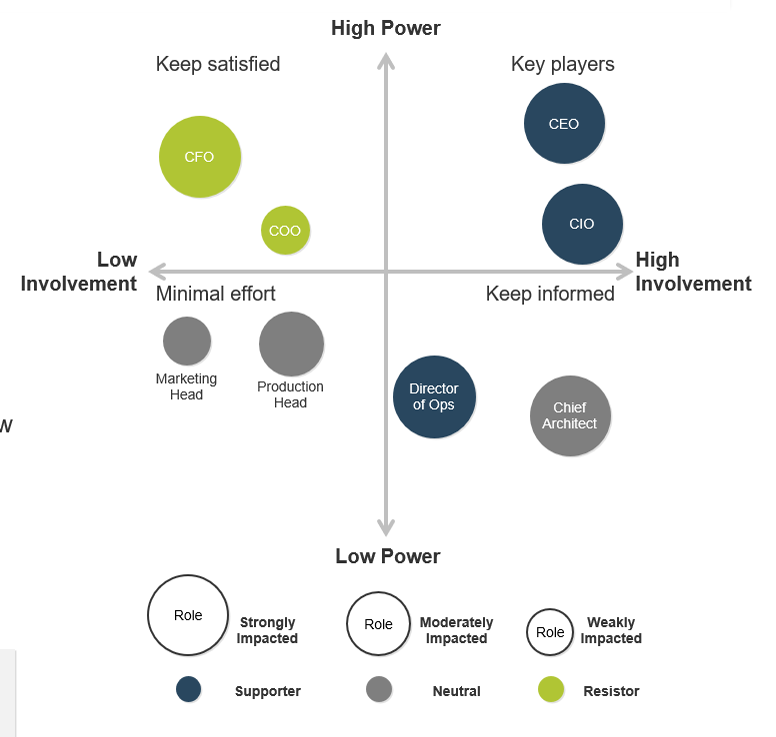
Download Info-Tech’s Stakeholder Power Map Template to help you visualize your key stakeholders.
Build a power map to prioritize stakeholders
![]() 1.1
1.1
It is important to identify who will be impacted and who has power, and the level of involvement they have in the governance redesign. If they have power, will be highly impacted, and are not involved in governance, you have already lost – because they will resist later. You need to get them involved early.
- Focus on key players – relevant stakeholders who have high power, are highly impacted, and should have a high level of involvement.
- Engage the stakeholders that are impacted most and have the power to impede the success of redesigning IT governance.
- For example, if a CFO, who has the power to block project funding, is heavily impacted and not involved, the IT governance redesign success will be put at risk.
- Some stakeholders may have influence over others so you should focus your efforts on the influencer rather than the influenced.
- For example, if an uncooperative COO is highly influenced by the Director of Operations, it is recommended to engage the latter.
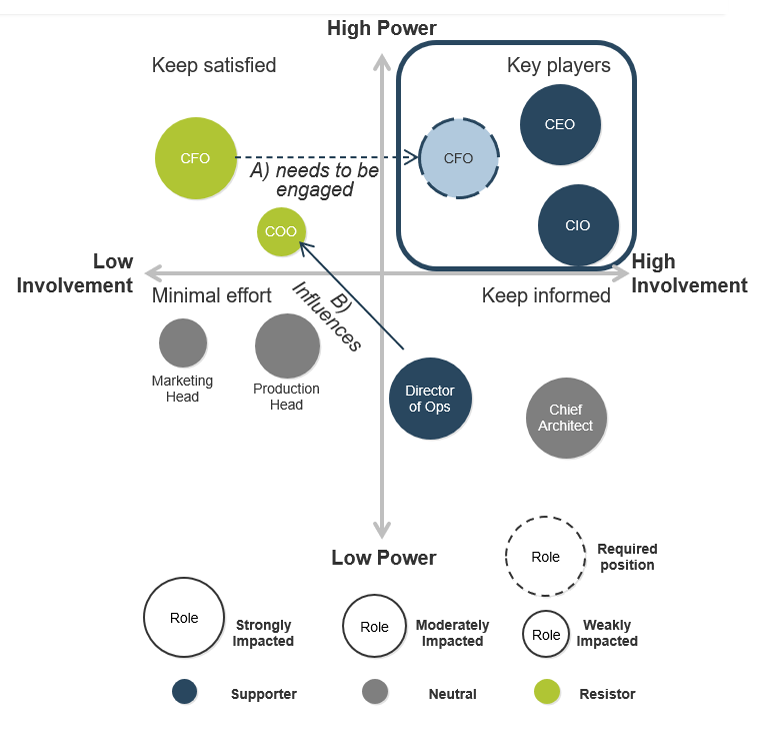
Identify specific pain points regarding business-IT alignment
INPUT: Signal Questions, CIO-CXO Alignment Diagnostic
OUTPUT: List of Categorized Pain Points
Materials: Make the Case for an IT Governance Redesign
Participants: Identified Key Business Stakeholders
- Consider Signals for Redesign
Refer to the Executive Brief for questions to identify pain points related to governance.- Benefits Realization
- Resources
- Risks
- Stakeholders
- Conduct CIO-CEO Alignment Diagnostic
Assess the current state of alignment between the CIO and the major stakeholders of the organization.
See the CEO-CIO Alignment Program for more information.
Conduct the CEO-CIO Alignment Diagnostic
Why CEO-CIO Alignment?
The CEO-CIO Alignment Program helps you understand the gaps between what the CEO wants for IT and what the CIO wants for IT. The program will also evaluate the current state of IT, from a strategic and tactical perspective, based on the CEO’s opinion.
The CEO-CIO Alignment Program helps to:
- Evaluate how the executive leadership currently feels about the IT organization’s performance along the following dimensions:
- IT budgeting and staffing
- IT strategic planning
- Degree of project success
- IT-business alignment
- Answer the question, “What does the CEO want from IT?”
- Understand the CEO’s perception of and vision for IT in the business.
- Define the current and target roles for IT. Understanding IT’s current and target roles, in the eyes of the CEO, is crucial to creating IT governance. By focusing the IT governance on achieving the target role, you will ensure that the senior leadership will support the implementation of the IT governance.
To conduct the CEO-CIO Alignment Program, follow the steps outlined below.
- Select the senior business leader to participate in the program. While Info-Tech suggests that the CEO participate, you might have other senior stakeholders who should be involved.
- Send the survey link to your senior business stakeholder and ensure the survey’s completion.
- Complete your portion of the survey.
- Hold a meeting to discuss the results and document your findings.
See the CEO-CIO Alignment Program for more information.
Present the “Make the Case” for IT governance redesign
![]() 1.3 30 minutes
1.3 30 minutes
- Review Finalized Stakeholder List
Consolidate a list of the most important and impactful stakeholders who need further convincing to participate in the governance redesign and implementation. - Present the Deck
Include the information gathered throughout the discovery into the presentation deck and hold a meeting to review the findings.
Business
- Shareholders
- Board
- Chief Executive Officer
- Chief Financial Officer
- Chief Operating Officer
- Business Executives
- Strategy Executive Committee
- Chief Risk Officer
- Architecture Board
- Enterprise Risk Committee
- Head of Human Resources
- Compliance
IT
- Chief Information Officer
External
- Government Agency
- Audit Firm
Use the Make the Case for an IT Governance Redesign template for more information.
Create a custom communication plan to facilitate support for the redesign process
![]() 1B Create a plan to engage the key stakeholders
1B Create a plan to engage the key stakeholders
INSTRUCTIONS
- Identify Stakeholders
Determine which business stakeholders will be involved (refer to Activity 1.1). - Customize Communication Plan
Follow up with individual communication plans.
Info-Tech Best Practice
Create personal communication plans to provide individualized engagement, instead of assuming that everyone will respond to the same communication style.
Download the IT Governance Stakeholder Communication Planning Tool for more information.
Create a communication plan to engage key stakeholders
- Input Stakeholders
Determine which business stakeholders will be involved (refer to Activity 1.1). Then, insert their position on the power map, the rationale to inform them, the timing of communications, and what inputs they will be needed to provide.Stakeholder role
Power map position
Why inform them
When to inform them
What we need from them
Chief Executive Officer Chief Financial Officer Chief Operating Officer - Identify Communication Strategy
Outline the most effective communication plan for that stakeholder. Identify how to best communicate to the stakeholders to make sure they are appropriately engaged in the redesign process.Vehicle
Audience
Purpose
Frequency
Owner
Distribution
Level of detail
Status Report IT Managers Project progress and deliverable status Weekly CIO, John Smith Email Details for milestones, deliverables, budget, schedule, issues, next steps Status Report Marketing Manager Project progress Monthly CIO, John Smith Email High-level detail for major milestone update and impact to the marketing unit
Establish a collectively agreed upon statement of business context (SoBC)
![]() 1C Document the mutual understanding of the business context
1C Document the mutual understanding of the business context
INSTRUCTIONS
- Review Business Documents
Review business documents from broad areas of the business to assess the business context. - Analyze Business Frameworks
Analyze business frameworks to articulate the current and projected future business context. - Brainstorm With Key Stakeholders
Conduct stakeholder brainstorming efforts to gain insights from key business stakeholders. - Finalize the SoBC
Document and sign the SoBC with identified stakeholders.
Info-Tech Best Practice
Use the Statement of Business Context customizable deliverable as a point of reference that will guide the direction of the governance redesign.
Use the Statement of Business Context to identify the critical information needed to guide governance
Components of the SoBC
|
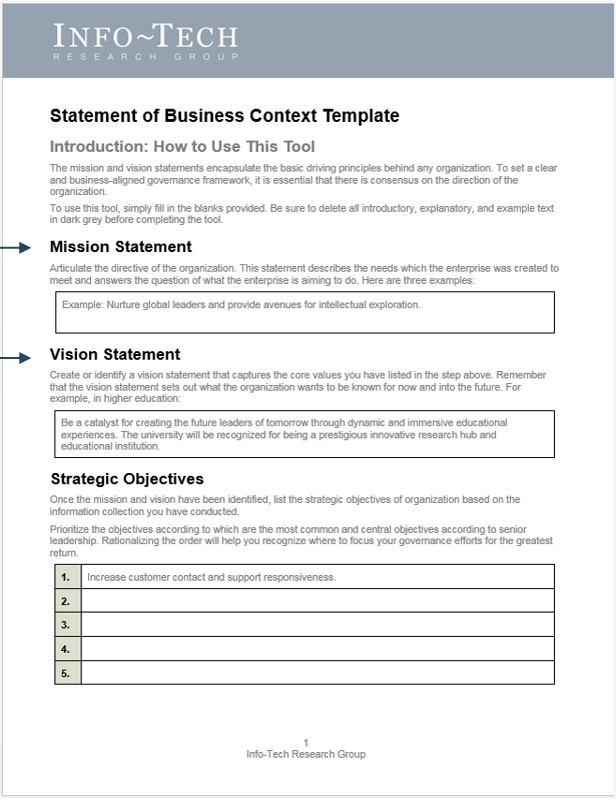 |
Use the Statement of Business Context to identify the critical information needed to guide governance (cont.)
More Components of the SoBC
|
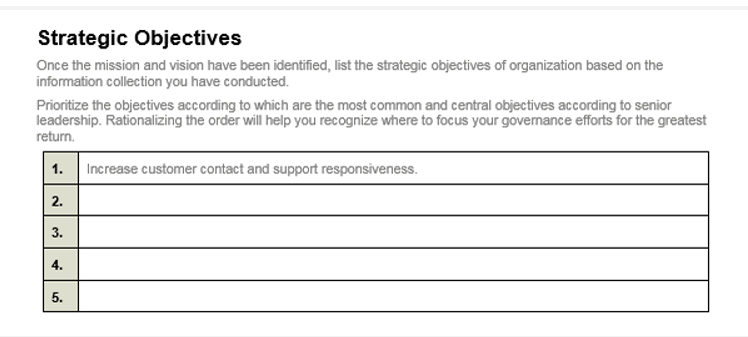 |
|
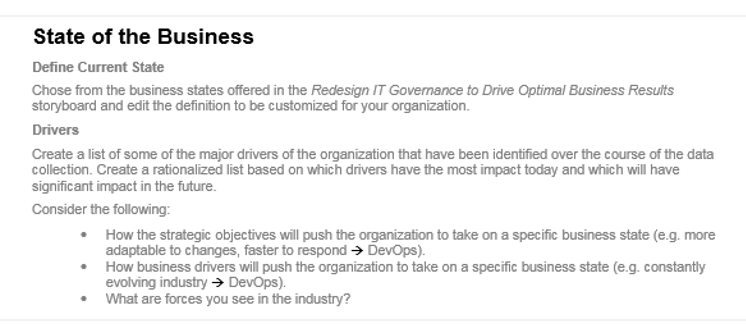 |
Leverage core concepts to determine the direction of the organization’s state of the business
|
–› |
Work through if your organization’s state is small vs. large, public vs. private, and lean vs. DevOps vs. traditional. |
SmallIT team is 30 people or less. |
LargeIT team is more than 30 people. |
|
PublicWholly or partly funded by the government. |
PrivateNo government funding is provided. |
|
| Lean: The business aims to eliminate any waste of resources (time, effort, or money) by removing steps in the business process that do not create value. | Devops/Agile: Our organization aims to make quick decisions and navigate the fast-paced industry with agility. Uniting the development and operational sides of the business. | Hierarchical: Departments in the organization are siloed by function. The organization is top-down and hierarchical, and takes more time with decision making. |
‹– Multi-State (any combination) –› |
||
Review business documents to assess business context
INPUT: Strategic Documents, Financial Documents
OUTPUT: Mission, Vision, Strategic Objectives
Materials: Corporate Documents
Participants: IT Governance Redesign Owner
Start assessing the state of the business context by leveraging easily accessible information. Many organization have strategic plans, documents, and presentations that already include a large portion of the information for the SoBC – use these sources first.
Instructions
- Strategic Documents
Leverage your organization’s strategic documents to gain understanding of the business context.
Documents to Review:
- Corporate strategy document.
- Business unit strategy documents.
- Annual general reports.
Leverage your organization’s financial documents to gain understanding of the business context.
Documents to Review:
- Look for large capital expenditures.
- Review operating costs.
- Business cases submitted.
Review strategic planning documents
Overview
Some organizations (and business units) create an authoritative strategy document. These documents contain the organization’s corporate aspirations and outline initiatives, reorganizations, and shifts in strategy. Additionally, some documents contain strategic analysis (Porter’s Five Forces, etc.).
Action
- Read through any of the following:
- Corporate strategy document
- Business unit strategy documents
- Annual general reports
- Watch out for key future-looking words:
- We will be…
- We are planning to…
Overt Statements
- Corporate objectives and initiatives are often explicitly stated in these documents. Look for statements that begin with phrases such as “Our corporate objectives are…”
- Remember that different organizations use different terminology – if you cannot find the word “goal” or “objective” then look for “pillar,” “imperative,” “theme,” etc.
- Ask a business partner to assist if you need some help.
Covert, Outdated, and Non-Existent Statements
- Some corporate objectives and initiatives will be mentioned in passing and will require clarification, for example:
“As we continue to penetrate new markets, we will be diversifying our manufacturing geography to simplify distribution.” - Some corporate strategies may be outdated and therefore of limited use for understanding the state of business – validate the statement to ensure it is up to date.
- Some organizations lack a strategic plan altogether. Use stakeholder interviews to identify imperatives and validate conflicting statements before moving on.
Review financial documentation
Overview
Departmental budgets highlight the new projects that will launch in the next fiscal year. The overwhelming majority of these projects will have IT implications. Additionally, identifying where the department is spending money will allow you to identify business unit initiatives and operational change.
Action
- Scan budgets:
- Look for large capital expenditures
- Review operating costs
- Review business cases submitted
- Look for abnormalities or changes:
- What does an increase in spending mean?
- Does IT need to change as a result?
Capital Budgets
- Capital expenditures are driven by projects, which map to corporate goals and initiatives.
- Look for large capital expenditures and cross-reference the outflows with any project plans that have been collected.
- If an expenditure cannot be explained by project plans, request additional information.
Operating Budgets
- Major changes to operating costs typically reflect changes to a business unit. Some of these changes affect IT capabilities and can be classified as corporate initiatives.
- Changes that should be classified as corporate initiatives are expansion or contraction of a labor force, outsourcing initiatives, and significant process changes.
- Changes that should not be classified as corporate initiatives are changes in third-party fees, consulting engagements, and changes caused by inflation or growth.
Analyze business frameworks to articulate context
![]() 1.6 2-4 hours
1.6 2-4 hours
INPUT: Industry Research, Organizational Research, Analysis Templates
OUTPUT: PESTLE and SWOT Analysis
Materials: Computer or Whiteboards and Markers
Participants: IT Governance Redesign Owner
If corporate documents denoting the key components of the SoBC are not easily available, or do not provide all information required, refer to business analysis frameworks to discover internal and external trends that impact the mission, vision, strategic objectives, and state of the business.
- Conduct a PESTLE Analysis
The PESTLE analysis will support the organization in identifying external factors that impact the business. Keep watch for trends and changes in the industry. - Conduct a SWOT Analysis
The SWOT analysis will be more specific to the organization and the industry in which it operates. Identify the unique strengths, weaknesses, opportunities, and threats for your organization.
Political |
Economic |
Social |
Technological |
Legal |
Environmental |
Strengths |
Weaknesses |
Opportunities |
Threats |
Conduct a PESTLE analysis
- Break participants into teams and divide the categories amongst them:
- Political trends
- Economic trends
- Social trends
- Technological trends
- Legal trends
- Environmental trends
- Have each group identify relevant trends under their respective categories. You must relate each trend back to the business by considering:
- How does this affect my business?
- Why do we care?
- Use the prompt questions on the next slide to help the brainstorming process.
- Have each team present its list and have remaining teams give feedback and additional suggestions.
Political. Examine political factors such as taxes, environmental regulations, and zoning restrictions.
Economic Examine economic factors such as interest rates, inflation rate, exchange rates, the financial and stock markets, and the job market.
Social. Examine social factors such as gender, race, age, income, disabilities, educational attainment, employment status, and religion.
Technological. Examine technological factors such as servers, computers, networks, software, database technologies, wireless capabilities, and availability of software as a service.
Legal. Examine legal factors such as trade laws, labor laws, environmental laws, and privacy laws.
Environmental. Examine environmental factors such as green initiatives, ethical issues, weather patterns, and pollution.
Download Info-Tech’s PESTLE Analysis Template to help get started.
Review these questions to help you conduct a PESTLE analysis
For each prompt below, always try to answer the question: how does this affect my business?
Political
- Will a change in government (at any level) affect your organization?
- Do inter-government or trade relations affect you?
- Are there shareholder needs or demands that must be considered?
Economical
- How are your costs changing (moving off-shore, fluctuations in markets, etc.)?
- Do currency fluctuations have an effect on your business?
- Can you attract and pay for top-quality talent (e.g. desirable location, reasonable cost of living, changes to insurance requirements)?
Social
- What are the demographics of your customers or employees?
- What are the attitudes of your customers or staff (do they require social media, collaboration, transparency of costs, etc.)?
- What is the general lifecycle of an employee (i.e. is there high turnover)?
- Is there a market of qualified staff?
- Is your business seasonal?
Technological
- Do you require constant technology upgrades (faster network, new hardware, etc.)?
- What is the appetite for innovation within your industry or business?
- Are there demands for increasing data storage, quality, BI, etc.?
- Are you looking at cloud technologies?
- What is the stance on “bring your own device”?
- Are you required to do a significant amount of development work in-house?
Legal
- Are there changes to trade laws?
- Are there changes to regulatory requirements, e.g. data storage policies or privacy policies?
- Are there union factors that must be considered?
Environmental
- Is there a push towards being environmentally friendly?
- Does the weather have any effect on your business (hurricanes, flooding, etc.)?
Conduct a SWOT analysis on the business
Break the group into two teams.
Assign team A internal strengths and weaknesses.
Assign team B external opportunities and threats.
- Have the teams brainstorm items that fit in their assigned grids. Use the prompt questions on the next slide to help you with your SWOT analysis.
- Pick someone from each group to fill in the grids on the whiteboard.
- Conduct a group discussion about the items on the list. Identify implications for IT and opportunities to innovate as you did for the other business and external drivers.
| Helpful to achieve the objective |
Harmful to achieve the objective |
|
| Internal Origin attributes of the organization |
Strength | Weaknesses |
| External Origin attributes of the environment |
Opportunities | Threats |
Download Info-Tech’s Business SWOT Analysis Template to help get started.
Review these questions to help you conduct your SWOT analysis on the business
Strengths (Internal)
- What competitive advantage does your organization have?
- What do you do better than anyone else?
- What makes you unique (human resources, product offering, experience, etc.)?
- Do you have location advantages?
- Do you have price, cost, or quality advantages?
- Does your organizational culture offer an advantage (hiring the best people, etc.)?
Weaknesses (Internal)
- What areas of your business require improvement?
- Are there gaps in capabilities?
- Do you have financial vulnerabilities?
- Are there leadership gaps (succession, poor management, etc.)?
- Are there reputational issues?
- Are there factors that are making you lose sales?
Opportunities (External)
- Are there market developments or new markets?
- Industry or lifestyle trends, e.g. move to mobile?
- Are there geographical changes in the market?
- Are there new partnerships or M&A opportunities?
- Are there seasonal factors that can be used to the advantage of the business?
- Are there demographic changes that can be used to the advantage of the business?
Threats (External)
- Are there obstacles that the organization must face?
- Are there issues with respect to sourcing of staff or technologies?
- Are there changes in market demand?
- Are your competitors making changes that you are not making?
- Are there economic issues that could affect your business?
Conduct brainstorming efforts to gain insights from key business stakeholders
INPUT: SoBC Template
OUTPUT: Completed SoBC
Materials: Computer, Phone, or Other Mechanism of Connection
Participants: CEO, CFO, COO, CMO, CHRO, and Business Unit Owners
There are two ways to gather primary knowledge on the key components of the SoBC:
- Stakeholder Interviews
Approach each individual to have a conversation about the key components of the SoBC. Go through the SoBC and fill it in together. - Stakeholder Survey
In the case that you are in a very large organization, create a stakeholder survey. Input the key components of the SoBC into an online survey maker and send it off the key stakeholders.
Use the SoBC as the guide to both the interview and the survey. Be clear about the purpose of understanding the business context when connecting with key business stakeholders to participate in the brainstorming. This is a perfect opportunity to establish or develop a relationship with the stakeholders who will need to buy into the redesigned governance framework since it will involve and impact them significantly.
Go directly to the information source – the key stakeholders
Overview
Talking to key stakeholders will allow you to get a holistic view of the business strategy. You will be able to ask follow-up questions to get a better understanding of abstract or complex concepts. Interviews also allow you to have targeted discussions with specific stakeholders who have in-depth subject-matter knowledge.
Action
- Talk to key stakeholders:
- Structure focused, i.e. CEO or CFO
- Customer focused, i.e. CMO or Head of Sales
- Operational focused, i.e. COO
- Lower-level employees or managers
- Listen for key pains that IT could alleviate.
Overcome the Unstructured Nature of Interviews
- Interviewees will often explicitly state objectives and initiatives.
- However, interviews are less formal and less structured than objective-oriented strategy documents. Objectives are often stated using informal language.
“We’re talking rev gen here. That’s the name of the game. If we can get a foothold in India, there’s huge upside potential.” (VP Marketing) - Further analysis might translate this into a corporate imperative: increase revenue by growing our market share in India to 8% by January of next year.
- If an imperative is unclear, ask the stakeholder for more detail.
- Understand how key stakeholders evaluate, direct, and monitor their own areas of the business; this will give you insight as to their style.
Receive final sign-off to proceed with developing the IT governance redesign
Document any project assumptions or constraints. Before proceeding with the IT governance activities, validate the statement of business context with senior stakeholders. When consensus has been reached, have them sign the final page of the document.
How to ensure sign-off:
- Schedule a meeting with the senior stakeholders and conduct a review of the document. This meeting presents a great opportunity to deliver your interpretation of management expectations and make any modifications.
- Obtaining stakeholder approval in person ensures there is no miscommunication or misunderstandings around the tasks that need to be accomplished to develop a successful IT governance.
- This is an iterative process; if senior stakeholders have concerns over certain aspects of the document, revise and review again.
- Final sign-off should only take place when mutual understanding has been reached.
Download the SoBC Template and complete for final approval.
Info-Tech Tip
In most circumstances, you should have the SoBC validated with the following stakeholders:
- CIO
- CEO
- CFO
- Business Unit Leaders
Understand the business context to set the foundation for governance redesign
CASE STUDY
Industry: Healthcare
Source: Info-Tech
Challenge
The new business direction to become an integrator shifted focus to faster software iteration and on enabling integration and translation technologies, while moving away from creating complete, top-to-bottom IT solutions to be leveraged by clinicians and patients.
Internal to the IT organization, this created a different in perspective on what was important to prioritize: foundational elements, web services, development, or data compliance issues. There was no longer agreement on which initiatives should move forward.
Solution
A series of mandatory meetings were held with key decision makers and SMEs within the organization in order to re-orient everyone on the overall purpose, goals, and outcomes of the organization.
All attendees were asked to identify what they saw as the mission and vision of the organization.
Finally, clinicians and patient representatives were brought in to describe how they were going to use the services the organization was providing and how it would enable better patient outcomes.
Results
Identifying the purpose of the work the IT organization was doing and how the services were going to be used realigned the different perspectives in the context of the healthcare outcomes they enabled.
This activity provided a unifying view of the purpose and the state of the business. Understanding the business context prepared the organization to move forward with the governance redesign.
If you want additional support, have our analysts guide you through this phase as part of an Info-Tech Workshop 
Book a workshop with our Info-Tech analysts:
 |
|
The following are sample activities that will be conducted by Info-Tech analysts with your team:
1.1 |
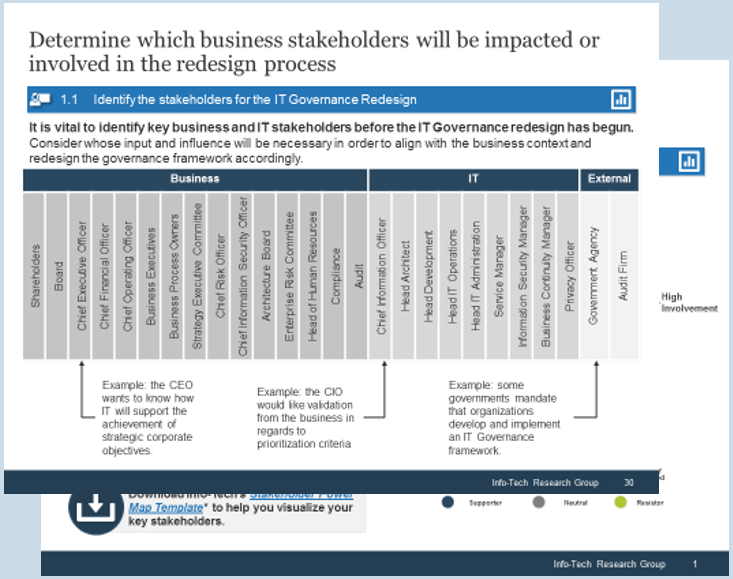 |
Identify Relevant Stakeholders
Build a list of relevant stakeholders and identify their position on the stakeholder power map. |
1.4 |
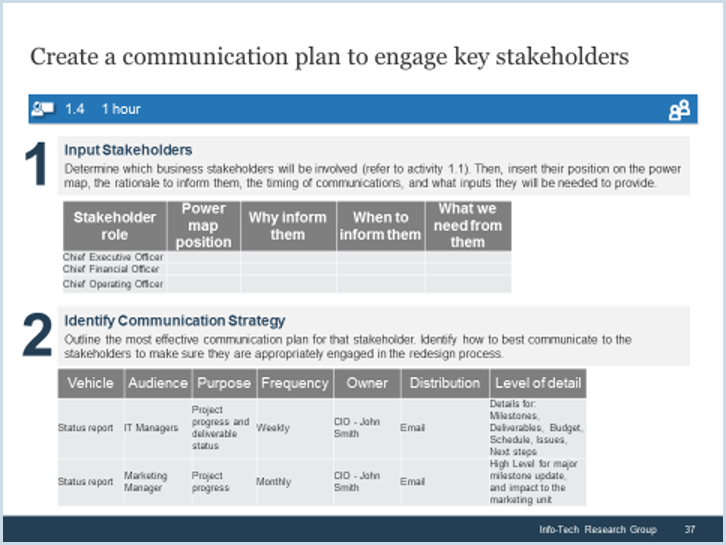 |
Communication Plan
Build customized communication plans to engage the key stakeholders in IT governance redesign. |
If you want additional support, have our analysts guide you through this phase as part of an Info-Tech Workshop
Book a workshop with our Info-Tech analysts:
1.7 |
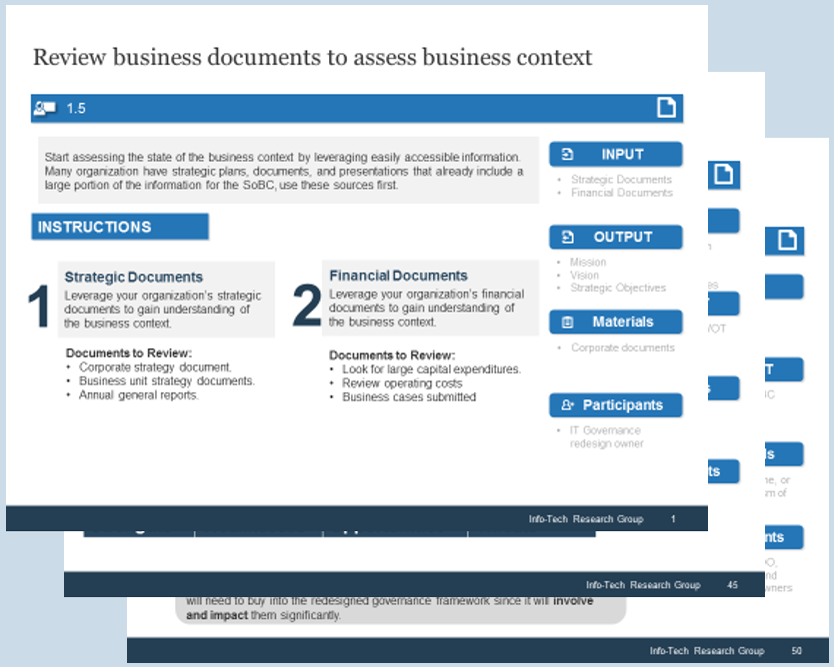 |
Gather Business Information
Review business documents, leverage business analysis tools, and brainstorm with key executives to document the Statement of Business Context. |
1.8 |
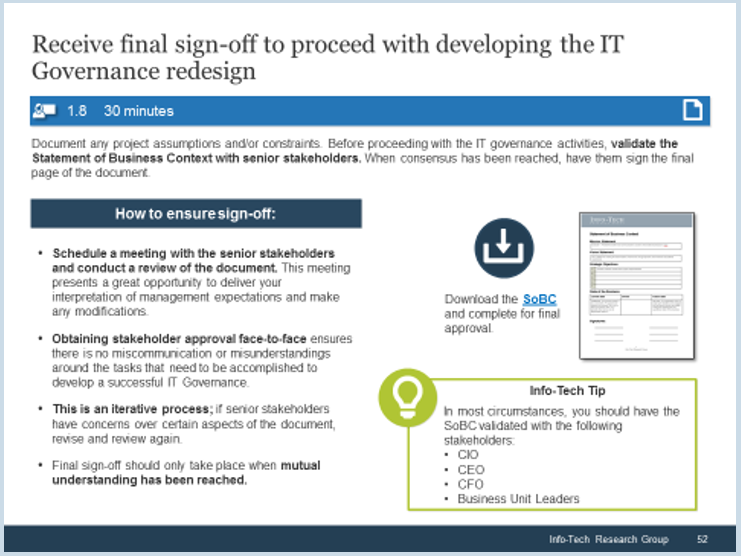 |
Finalize the Statement of Business Context
Get final approval and acceptance on the Statement of Business Context that will guide your redesign. |
Improve IT Governance to Drive Business Results
PHASE 2
Assess the Current Governance Framework
Phase 2 outline
![]() Call 1-888-670-8889 or email GuidedImplementations@InfoTech.com for more information.
Call 1-888-670-8889 or email GuidedImplementations@InfoTech.com for more information.
Complete these steps on your own, or call us to complete a guided implementation. A guided implementation is a series of 2-3 advisory calls that help you execute each phase of a project. They are included in most advisory memberships.
Guided Implementation 2: Assess the Current Governance Framework
Proposed Time to Completion: 2 weeks
| Step 2.1: Outline the Current State Assessment | Step 2.2: Review the Current State Assessment |
Start with an analyst kick-off call:
| Review findings with analyst:
|
Then complete these activities…
| Then complete these activities…
|
With these tools & templates:
| With these tools & templates:
|
Phase 2: Assess the Current Governance Framework
| 1 | 2 | 3 | 4 |
| Align IT With the Business Context | Assess the Current Governance Framework | Redesign the Governance Framework | Implement Governance Redesign |
Activities:
- 2.1 Create Committee Profiles
- 2.2 Build a Governance Structure Map
- 2.3 Establish Governance Guidelines
Outcomes:
- Use the Current State Assessment of IT Governance to determine governance guidelines.
Info-Tech Insight
Don’t be passive; take action! Take an active approach to revising your governance framework. Understand why you are making decisions before actually making them.
Explore the current governance that exists within your organization
Your current governance framework will give you a strong understanding of the way the key stakeholders in your business currently view IT governance.
"Much of the focus of governance today has been on the questions:
|
–› | "We need to shift to…
|
Leverage this understanding of IT governance to determine where governance is occurring and how it transpires.
Conduct a current state assessment
Use this tool to critically assess each governing body to determine the areas of improvement that are necessary in order to achieve optimal business results.
- Identify All Governing Bodies
Some bodies govern intentionally, and some govern through habit and practice. Outline all bodies that take on an element of governance. - Create a Governance Structure Map
Configure the structural relationships for the governing bodies using the structure map. - Reveal Strengths and Weaknesses
Identify the strengths and weaknesses of the governance structure, authority definitions, processes, and membership. - Establish Governance Guidelines
Based on the SoBC, express clear and applicable guidelines to improve on the weaknesses while retaining the strengths of your governance framework.
Download the Current State Assessment of IT Governance to work toward these outcomes
Conduct a current state assessment to identify governance guidelines
How to use the Current State Assessment of IT Governance deliverable: Follow the steps below to create a cohesive understanding of the current state of IT governance and the challenges that the current system poses.
Part A – Committee Profiles
|
Part B – Structure Map
|
Part C – Governance Guidelines
|
|
What makes up the “governance framework”?
There are four major elements of the governance framework:
- Structure
Structural relationships are shown by mapping the connections between committees. - Authority
Each committee will have a purpose and area of decision making that it is accountable for. - Process
The process includes the inputs, outputs, and activities required for the committee to function. - Membership The individuals or roles who sit on each committee. Take into account members’ knowledge, capability, and political influence.
Create governing board or committee profiles
Part A – Committee Profiles
Identify Governing Bodies
Establish where governance happens and who is governing. For different organizations, the governance framework will contain a variety of governing bodies or people. Use a list format to identify governing bodies that exist in your organization.Leverage Committee Templates
Use the templates provided. Create a profile for each governing body that currently operates in your IT governance framework as listed in step 1.Create Committee Profiles
Identify what they are governing and how they are governing.
Using the profiles created in step 2, identify each body’s membership roles, purpose, decision areas, inputs, and outputs. Refer to the example text in the template to guide you, but feel free to adjust the text to reflect the reality of your governing body.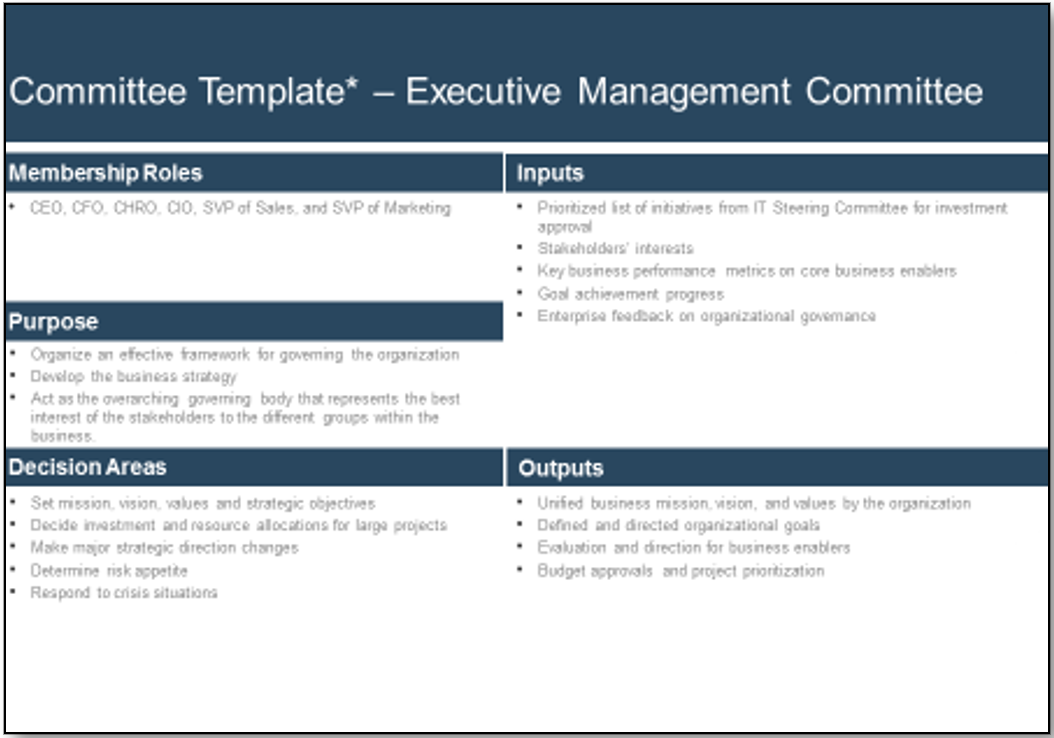
Consider the following domains of governance:
(refer to Executive Brief)- Benefits realization
- Risks
- Resources
Consistently define the components of governance in the committee profiles
Membership
Membership Roles
Insert information here that reflects who the individuals are that sit on that governing body and what their role is. Include other important information about the individuals’ knowledge, skills, or capabilities that are relevant.
Authority
Purpose
Define why the committee was established in the first place.
Decision Areas
Explain the specific areas of decision making this group is responsible for overseeing.
Process
Inputs
Consider the information and materials that are needed to make decisions.
Outputs
Describe the outcomes of the committee. Think about decisions that were made through the governance process.
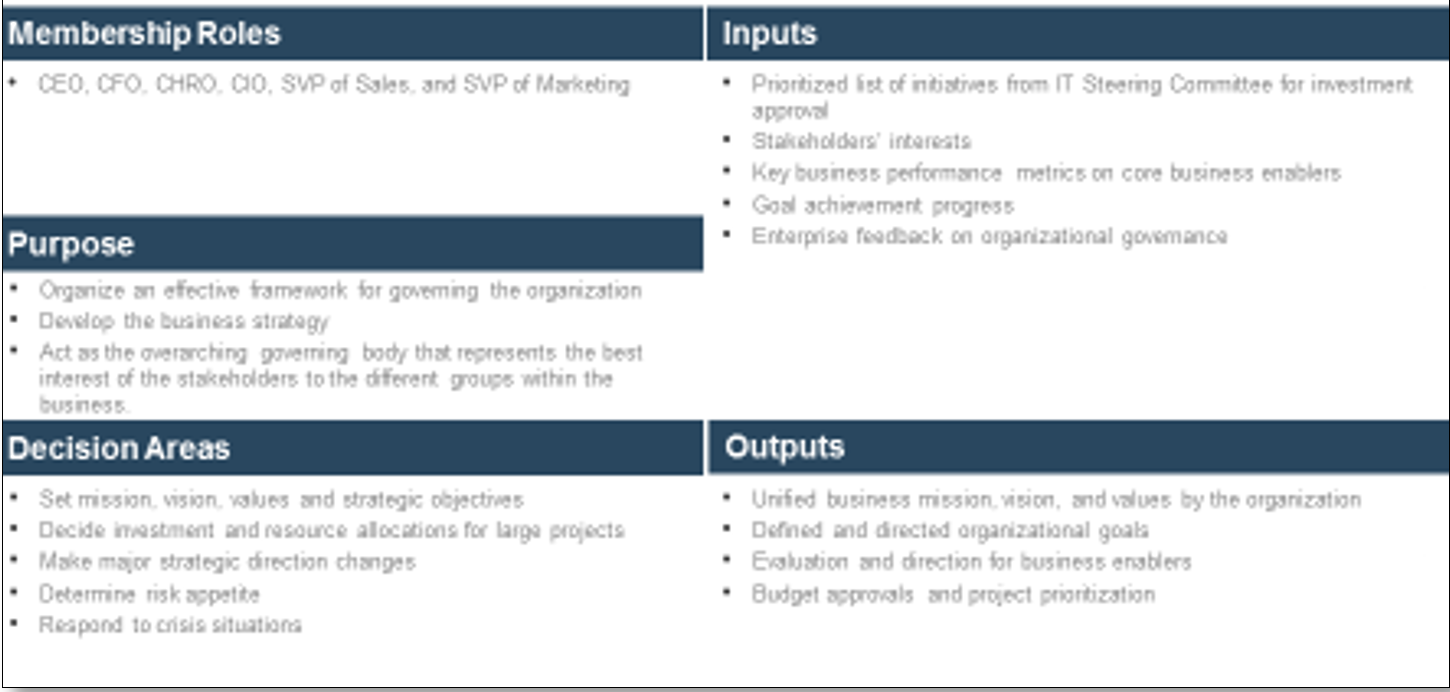
Map out relationships on the Governance Map
Part B – Structure Map
Structure
- Assess Inputs and Outputs
To understand relationships between governing bodies, list the inputs and outputs for each unique committee that rely on other committees in the table provided.Governing Bodies
Inputs
Outputs
Committee #1 Committee #2 Committee #3 CFO IT Director CIO - Create Structure Map
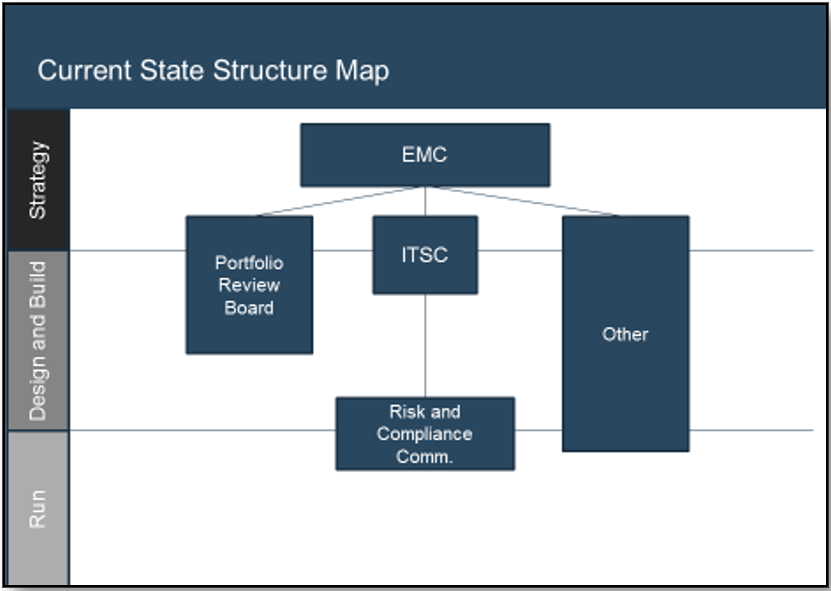 Using the outline provided, create your own governance structure map to represent the way the governing bodies interact and feed into each other.
This is crucial to ensure that the governing structure is streamlined. It will ensure that communication occurs efficiently and that there are no barriers to making decisions swiftly.
Using the outline provided, create your own governance structure map to represent the way the governing bodies interact and feed into each other.
This is crucial to ensure that the governing structure is streamlined. It will ensure that communication occurs efficiently and that there are no barriers to making decisions swiftly.
Outline the governance structure in the governance structure map
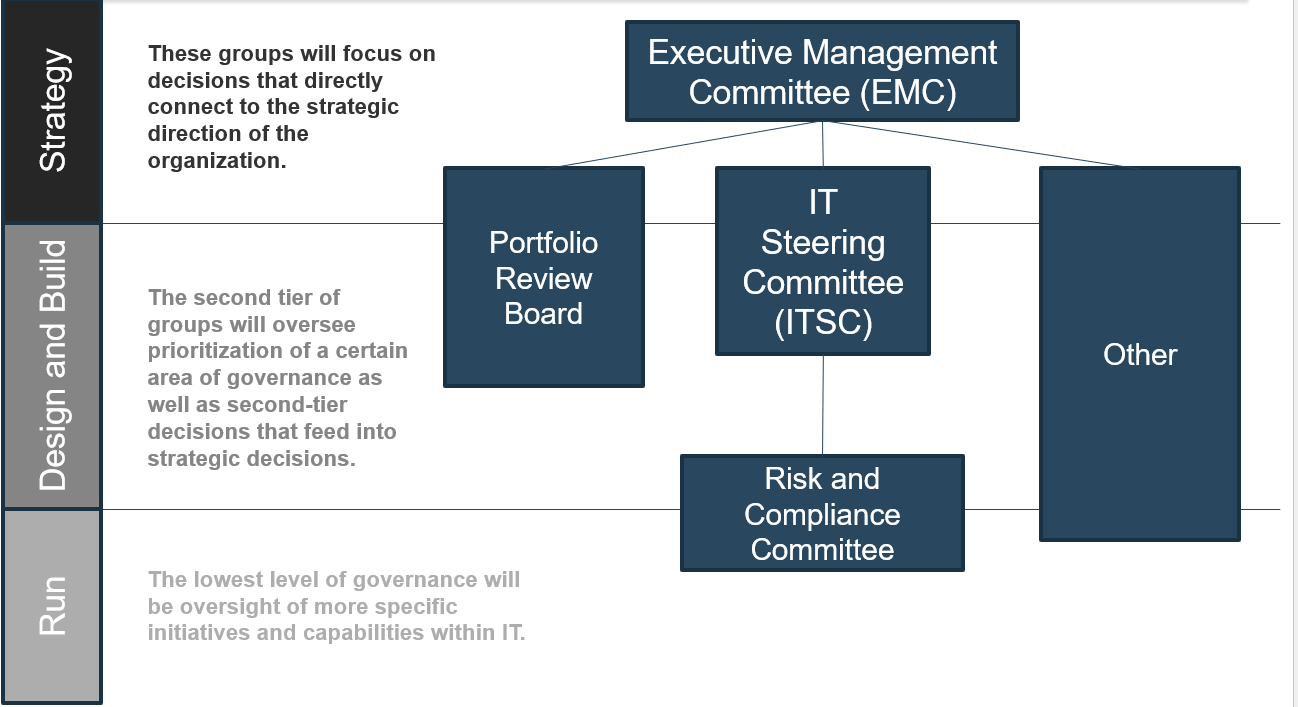
Identify strengths and weaknesses of the governance framework
Part C – Governance Guidelines
- Choose Business State Template
Choose the template that represents the identified future state of business in the Statement of Business Context.
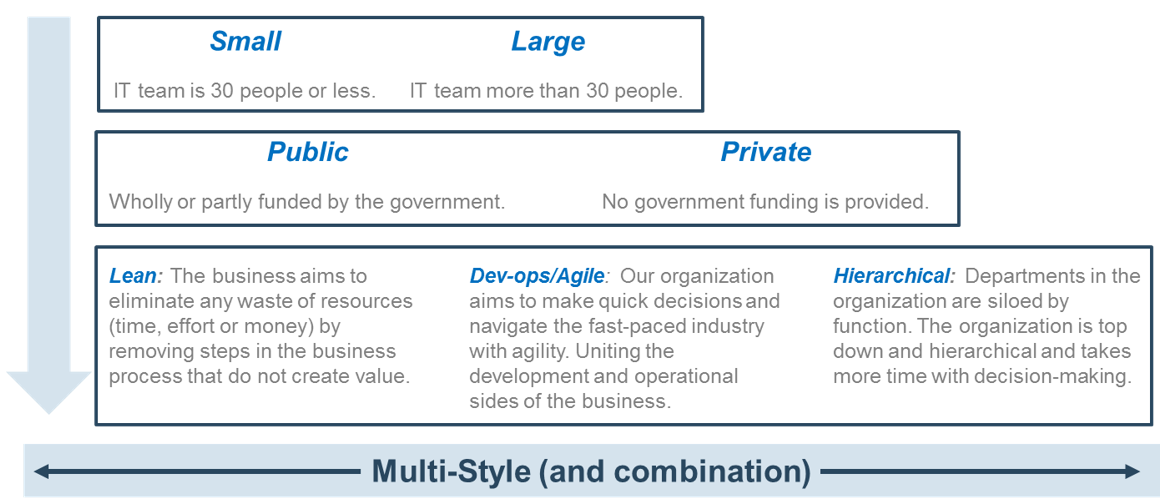
- Identify Strengths and Weaknesses
Input the major strengths and weaknesses of your governance that were highlighted in the brainstorming activity.

- Establish Governance Guidelines
Draw your own implications from the strength and weaknesses that will drive the design of your governance in its future state. These guidelines should be concise and easy to implement.
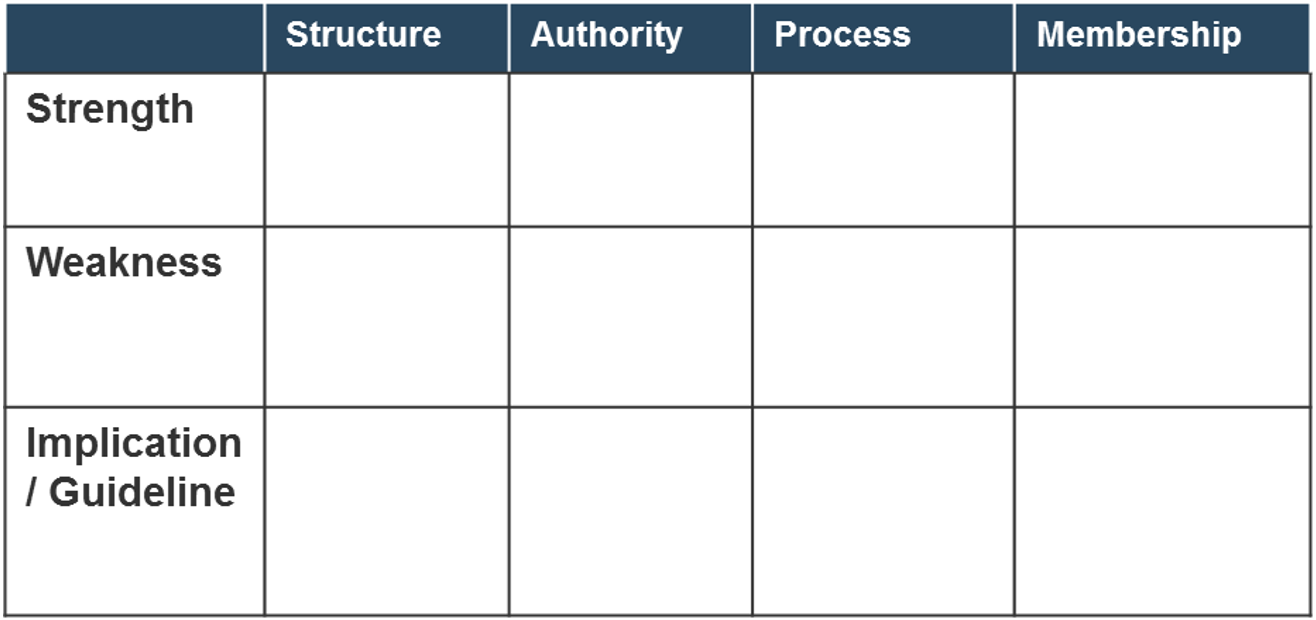 Note: Refer to the example guidelines in the Current State Assessment of IT Governance after you have considered your own specific guidelines. The examples are supplementary for your convenience.
Note: Refer to the example guidelines in the Current State Assessment of IT Governance after you have considered your own specific guidelines. The examples are supplementary for your convenience.
Distinguish your business state from the others to ensure implications act as accurate guidelines
Business State Options
1 | SmallIT team is 30 people or less. | LargeIT team is more than 30 people. | |
2 | PublicWholly or partly funded by the government. | PrivateNo government funding is provided. | |
3 | Lean: The business aims to eliminate any waste of resources (time, effort, or money) by removing steps in the business process that do not create value. | Devops: Our organization aims to make quick decisions and navigate the fast-paced industry with agility. Uniting the development and operational sides of the business. | Hierarchical: Departments in the organization are siloed by function. The organization is top-down and hierarchical, and takes more time with decision making. |
‹– Multi-State (any combination) –›Multi-State Example A: If you are small organization that is publicly funded and you are shifting towards a lean methodology, combine the implications of all those groups in a way that fits your organization. Multi-State Example B: Your organization is shifting from a more traditional state of operating to combining the development and operations groups. Use hierarchical implications to govern one group and DevOps implications for the other. | |||
Identify strengths and weaknesses of the governance framework
![]() 2.3 2 hours
2.3 2 hours
INSTRUCTIONS
- Input Strengths of Governance
Include useful components of the current framework; that may include elements that are operating well, fit the future state, or are required due to regulations or statutes. - Determine Weaknesses and Challenges
Discuss the pain points of the current governance framework by looking through the lenses of structure, authority, process, or membership.
Consider:
- Where is governance not meeting expectations?
- Are we doing the right things?
- Are we getting the benefits?
- What are the outcomes?
- What do we want to achieve?
- How do we make intelligent decisions about what will help us achieve those outcomes?
*Example | Structure | Authority | Process | Membership |
Strength |
|
|
|
|
Weakness |
|
|
|
|
Derive governance implications from strengths and weaknesses
![]() 2.3 2-4 hours
2.3 2-4 hours
INSTRUCTIONS
- Copy and paste your strengths and weaknesses from part B into the template that reflects your business state.
- Draw your own implications from the strengths and weaknesses that will drive the design of your governance in its future state. These guidelines should be concise and practical.
*Example | Structure | Authority | Process | Membership |
Strength | ||||
Weakness | ||||
Implication / Guideline |
|
|
|
|
Note: Use the examples of guidelines provided in the Current State Assessment of IT Governance to help formulate your own.
Conduct a current state assessment to identify guidelines for the future state of governance
CASE STUDY
Industry: Healthcare
Source: Anonymous
Challenge
Over time, the organization had to create a large amount of governing committees and subcommittees in order to comply with governance frameworks applied to them and to meet regulatory compliance requirements.
The current structure was no longer optimal to meet the newly identified mandate of the organization. However, the organization did not want to start from scratch and scrap the elements that worked, such as the dates and times that had been embedded into the organization.
Solution
A current state assessment was planned and executed in order to review what was currently being done and identify what could be retained and what should be added, changed, or removed to improve the governance outcomes.
The scope involved examining how current and near-term governance needs were, or were not, met through the existing structure, bodies, and their processes.
The organization investigated governance approaches of organizations with similar governance needs and with similar constraints to model their own.
Results
The outputs of this exercise included:
- A list of effective practices and committee guidelines that could be leveraged with little to no change in the future state.
- A list of opportunities to streamline the structure and processes.
These guidelines were used to drive recommendations for improvements to the governance structures and processes in the organization.
If you want additional support, have our analysts guide you through this phase as part of an Info-Tech Workshop 
Book a workshop with our Info-Tech analysts:
 |
|
The following are sample activities that will be conducted by Info-Tech analysts with your team:
2.1 |
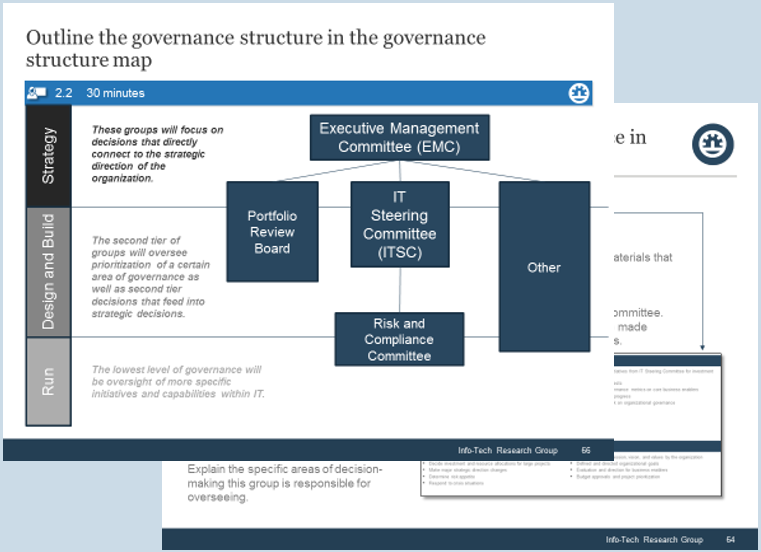 |
Create Current State Structure and Profiles
Take the time to clearly articulate the current governance framework of your organization. Outline the structure and build the committee profiles for the governing bodies in your organization. |
2.3 |
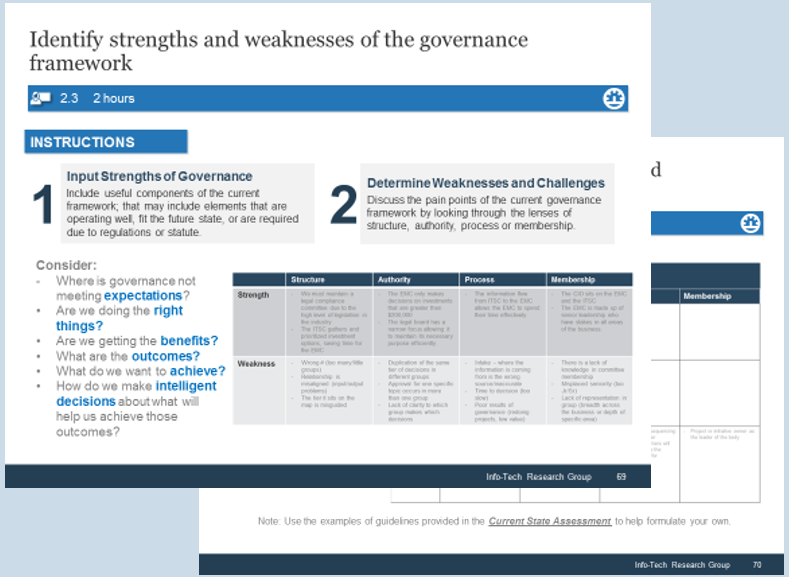 |
Determine Strengths, Weaknesses, and Guidelines
Evaluate the strengths of your governance framework, the weaknesses that it exhibits, and the guidelines that will help maintain the strengths and alleviate the pains. |
Improve IT Governance to Drive Business Results
PHASE 3
Redesign the Governance Framework
Phase 3 Guided Implementation
![]() Call 1-888-670-8889 or email GuidedImplementations@InfoTech.com for more information.
Call 1-888-670-8889 or email GuidedImplementations@InfoTech.com for more information.
Complete these steps on your own, or call us to complete a guided implementation. A guided implementation is a series of 2-3 advisory calls that help you execute each phase of a project. They are included in most advisory memberships.
Guided Implementation 3: Redesign the Governance Framework
Proposed Time to Completion: 4 weeks
| Step 3.1: Understand the Redesign Process | Step 3.2: Review Governance Structure | Step 3.3: Review Governance Committees |
Start with an analyst kick-off call:
|
Review findings with analyst:
|
Finalize phase deliverable:
|
Then complete these activities…
|
Then complete these activities…
|
Then complete these activities…
|
With these tools & templates:
|
With these tools & templates:
|
With these tools & templates:
|
Phase 3: Redesign the Governance Framework
| 1 | 2 | 3 | 4 |
| Align IT With the Business Context | Assess the Current Governance Framework | Redesign the Governance Framework | Implement Governance Redesign |
Activities:
- 3.1 Build a Governance Structure Map
- 3.2 Create Committee Profiles
- 3.3 Leverage Process-Specific Governance Blueprints
Outcomes:
- Use the Future State Design for IT Governance template to build the optimal governance framework for your organization.
Info-Tech Insight
Keep the current and future goals in sight to build an optimized governance framework that maintains the minimum bar of oversight required.
Anticipate the outcomes of the Future State Design for IT Governance tool
Use this tool to guide your organization toward transformative outcomes gleaned from an optimized governance framework.
- Implement Structural Guidelines
Determine what governing bodies to add, change, or remove from your governance structure. - Create a Governance Structure Map
Configure the structural relationships for the redesigned governing bodies using the structure map. - Build Effective Committees
Use the IT Governance Terms of Reference to build profiles for each newly created committee and to alter any existing committees. - Determine Follow-up Governance Support
Access external material on governance from other Info-Tech blueprints that will help with specific governance areas.
Download the Future State Design for IT Governance template to work toward these outcomes.
Use the Future State Design for IT Governance tool to create a custom governance framework for your organization
How to use the Future State Design for IT Governance deliverable: Follow the steps below to redesign the future state of IT governance. Use the guidelines to respond to challenges identified in the current governance framework based on the current state assessment.
Part A – Structure Map |
Part B – Committee Profiles |
||
| 1a. Input Structural Guidelines | 1b. Input Authority Guidelines | 1a. Input Process Guidelines | 1b. Input Member Guidelines |
| 2. Guiding Questions
Do governing bodies operate at a tier that matches the guidelines? |
Do governing bodies focus on the decisions that align with the guidelines? |
2. Guiding Questions
Do the process inputs and outputs reflect the structure and authority guidelines? |
Do governing bodies engage the right people who have the roles, capacity, and knowledge to govern? |
| 3. Add / Change (Tier/Authority) / Remove Governing Bodies – Structure |
3. Adapt / Refine Governing Bodies – Profiles |
||
| 4. Use the Structure Map to Show Redesign | Use the IT Governance Terms of Reference for Redesign | ||
Connect key learnings to initiate governance redesign
The future state design will reflect the state of business that was identified in Phase 1 along with the guidelines defined in Phase 2 to build a governance framework that promotes business-IT fusion.
| Statement of Business Context | –› | Current State Assessment |
Identified Future Business StateStructureAuthorityLeverage the structure and authority guidelines to build the governance structure. |
Defined Governance GuidelinesProcessMembershipLeverage the process and membership guidelines to build the governance committees. |
|
| Future State Design | ||
Use structure and authority guidelines to build a new governance structure map
![]() 3A.1 Redesign the governance frameworks
3A.1 Redesign the governance frameworks
Part A – Structure Map
Structure | Authority |
| 1a. Structural Guidelines | 1b. Authority Guidelines |
| Input the guidelines from the current state assessment to guide the redesign. | |
2. Leverage Guiding QuestionsUse the guiding questions provided to assess the needed changes. | |
| Guiding Questions | Do governing bodies focus on the decisions that align with the guidelines? |
| Build the “where/why” of governance. Consider at what tier each committee will reside and what area of governance will be part of its domain. Modify the current structure; do not start from scratch. | |
3. Add / Change (Tier/Authority) / Remove | |
| Determine changes to structure or authority that will be occurring for each of the current governing bodies. Work within the current structure as much as possible. | 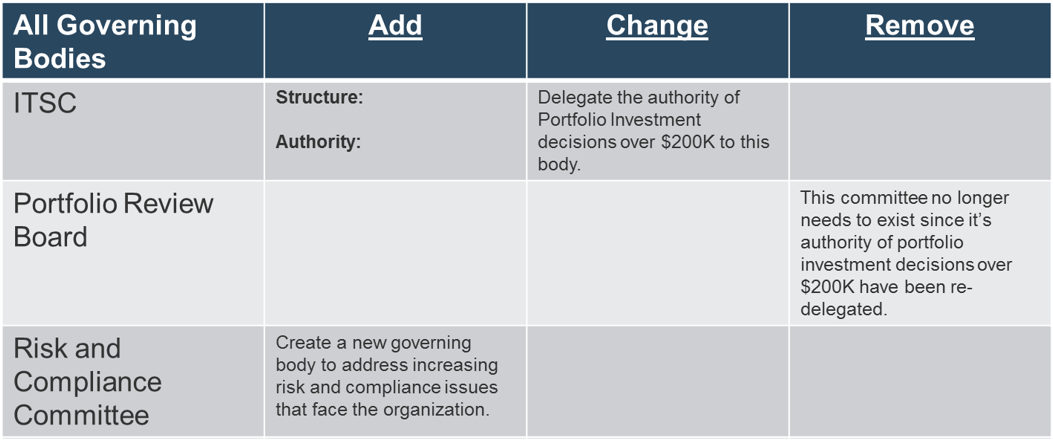 |
4. Use the Structure Map to Show Redesign | |
| Create your own governance structure map to represent the way the governing bodies interact and feed into each other. |  |
Maintain as much of the existing framework as possible in the redesign
![]() 3.1 2-4 hours
3.1 2-4 hours
Future State Design
- Structure
- Authority
Info-Tech Best Practice
Keep the number of added or removed committees as low as possible, while still optimizing. The less change to the structure, the easier it will be to implement.
Refer to the example to help guide your committee redesign.
- Determine:
- Do the guidelines impact committees you already have? Will you have to modify the tier or the authority of those committees?
- Do the guidelines require you to build a new committee to meet needs?
- Do the guidelines require you to remove a committee that isn’t necessary?
All Governing Bodies |
Add |
Change |
Remove |
| ITSC | Structure Authority |
Delegate the authority of portfolio investment decisions over $200K to this body | |
| Portfolio Review Board | This committee no longer needs to exist since its authority of portfolio investment decisions over $200K has been redelegated | ||
| Risk and Compliance Committee | Create a new governing body to address increasing risk and compliance issues that face the organization |
Outline the new governance structure in the governance structure map in the Future State Design for IT Governance tool
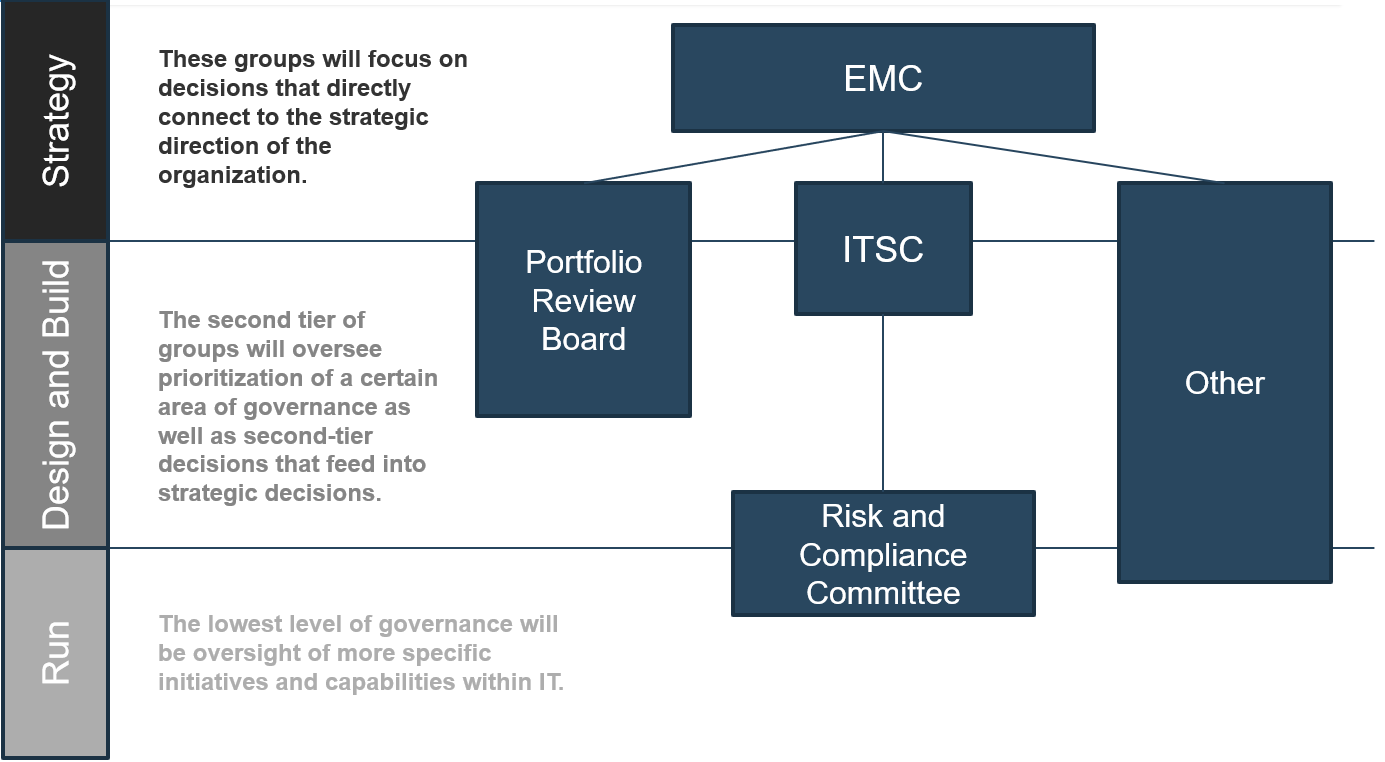
Use process and membership guidelines along with the IT Governance Terms of Reference to build committees
Part B – Committee Profiles
Process |
Membership |
| 1a. Process Guidelines | 1b. Authority Guidelines |
| Input the guidelines from the current state assessment to guide the redesign. | |
2. Leverage Guiding QuestionsUse the guiding questions provided to assess the needed changes. |
|
| Guiding Questions
Do the process inputs and outputs reflect the structure and authority guidelines? |
Do governing bodies engage the right people who have the roles, capacity, and knowledge to govern? |
| Build the “what/how” of governance. Build out the process and procedures that each committee will use. | |
3. Adapt / Refine Governing Body ProfilesUsing your customized guidelines, create a profile for each committee. |
|
We have provided templates for some common committees. To make these committee profiles reflective of your organization, use the information you have gathered in your Current State Assessment of IT Governance guidelines. For a more detailed approach to building out specific charters for each committee refer to the IT Governance Terms of Reference. |
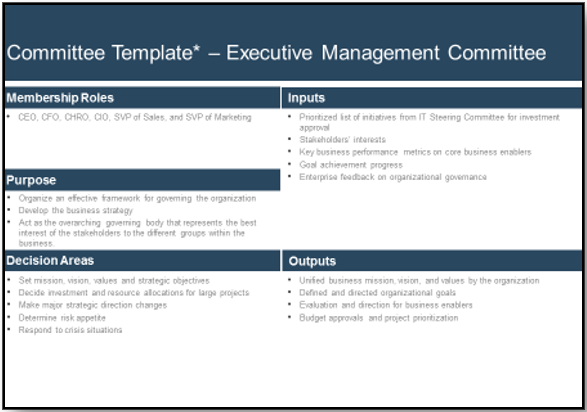 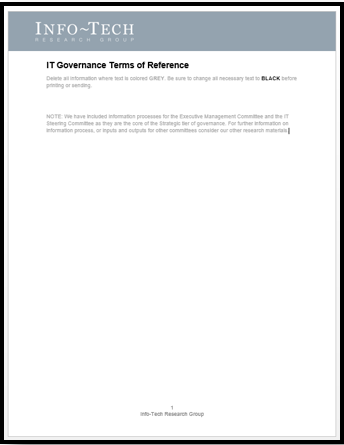 |
Use the IT Governance Terms of Reference to establish operational procedures for governing bodies
![]() 3.2 3-6 hours
3.2 3-6 hours
Future State Design
- Process
- Membership
Info-Tech Best Practice
The people on the committee matter. Governance committee membership does not have to correspond with the organizational structure, but it should correspond with the purpose and decision areas of the governance structure.
Refer to the example to help guide your committee redesign.
- Determine:
- Do the guidelines alter the members needed to achieve the outcomes?
- Do the guidelines change the purpose and decision areas of the committee?
- How do the new structure’s guidelines impact the inputs and outputs of the governing body?

Add depth to the committee profiles using the IT Governance Terms of Reference
Refer to the sections outlined below to build a committee charter for your governance committees. Four examples are provided in the tool and can be edited for your convenience. They are: Executive Management Committee, IT Steering Committee, Portfolio Review Board, and Risk and Compliance Committee.
- Purpose
- Goals
- Responsibilities
- Committee Members
- RACI
- Procedures
- Agenda
Be sure to embed the domains of governance in the charters so that committees focus on the appropriate elements of benefits realization, risk optimization, and resource optimization.
Download the IT Governance Terms of Reference for more in-depth committee charters.
Three pillars of planning effective governance meetings
The effectiveness of the governance is reliant on the ability to work within operational dependencies that will exist in the governance framework. Consider these questions to guide the duration, frequency, and sequencing of your governing body meetings.
Frequency
Duration
Sequencing
| 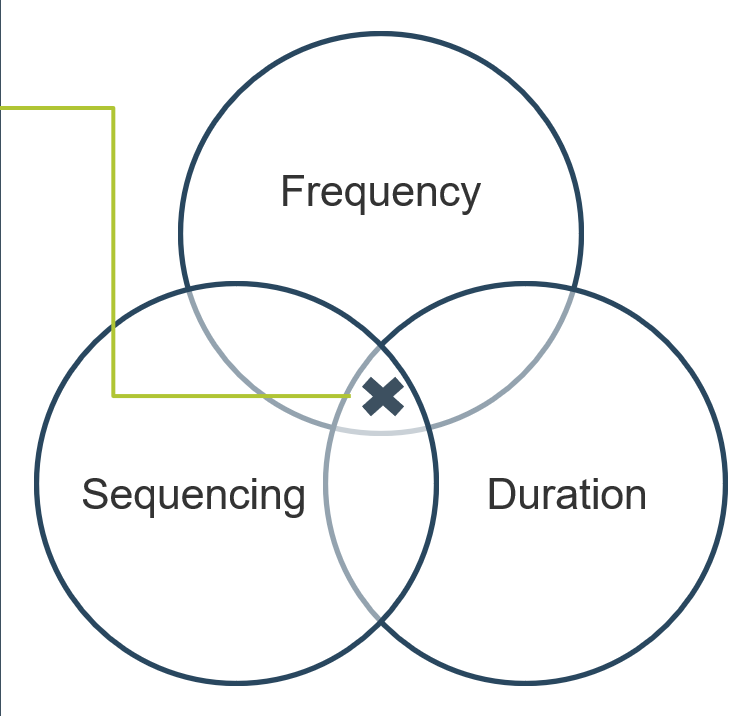 |
Leverage process-specific governance blueprints
If there are specific areas of IT governance that you require further support on, refer to Info-Tech’s library of DIY blueprints, Guided Implementations, and workshops for further support. We cover IT governance in the following areas:
Enterprise Architecture Governance |
Service Portfolio Governance |
Security Governance |
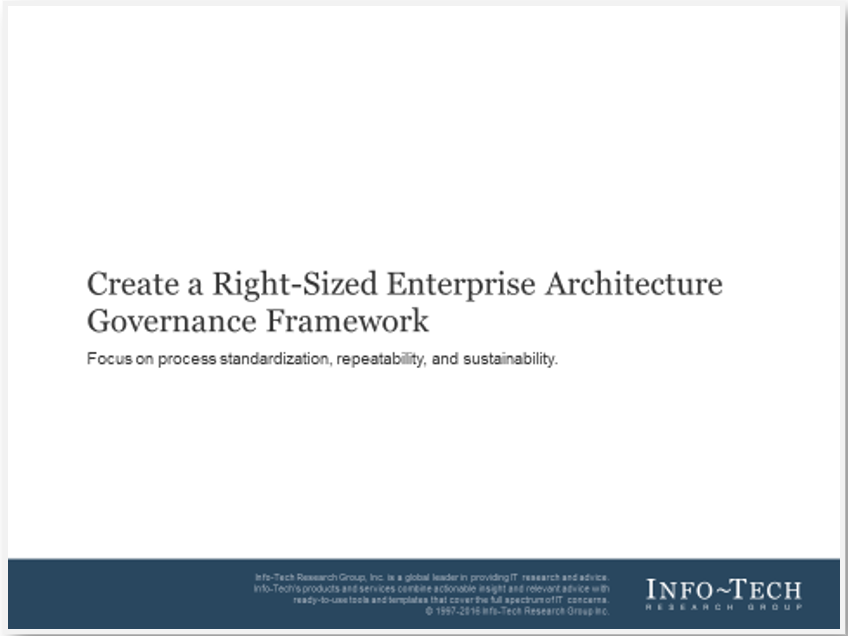 |
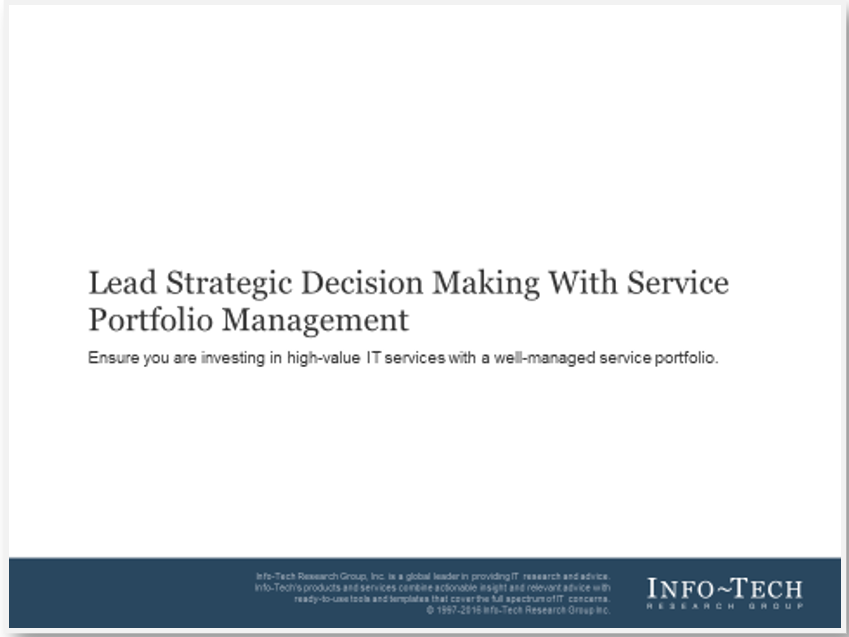 |
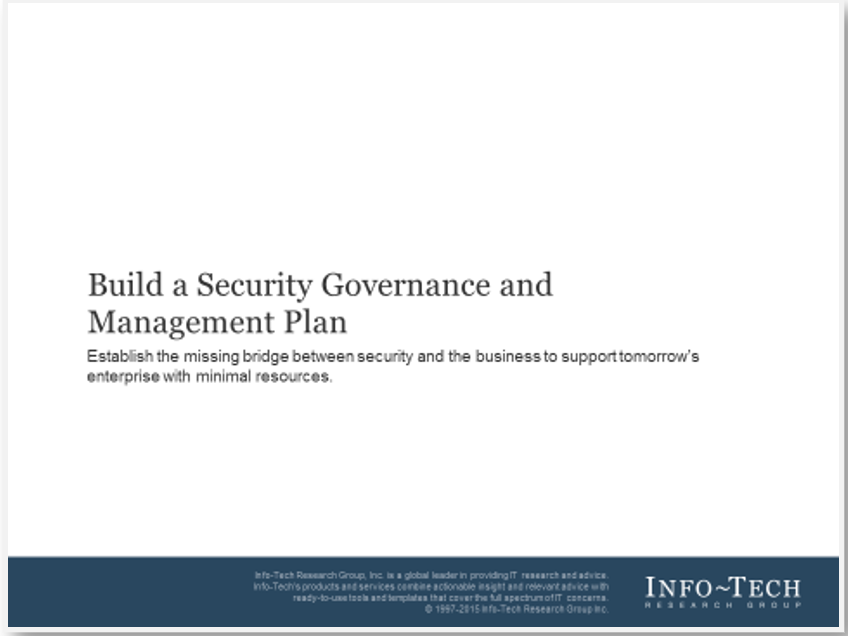 |
Consider the challenges and solutions when identifying a multi-state reality for your business state
A multi-state business will face unique challenges in navigating the redesign process with the goal of combining all related business states in governance.
- Divergent Governance Models
Separate the governance groups that need to function differently, and bring them back together at the highest level. - Reflecting the Organizational Structure
Unlike single-state governance, multi-state organizations should model the governance framework in reflection of the organizational structure. - Combining Implications
Prioritize which implications are the most important and make sure they work first, then see what else fits (e.g. start with regulation, then insert lean guidelines).
The multi-state business will not fit into one “box” – consider implications from the overlapping business states.
As business needs change, ensure that you establish triggers to reassess the design of your governance framework.
Leverage the outcomes of the Current State Assessment and Statement of Business Context to build the future state
CASE STUDY
Industry: Healthcare
Source: Info-Tech
Challenge
Identifying the committees and processes that should be in place in the target state required a lot of different inputs.
A number of high-profile senior management team members were still resistant to the overall idea of applying governance to their initiatives since they were clinician driven.
The approach and target state, including the implementation plan, had to be approved and built out.
Solution
The information pulled together from the current state assessment, including best practices and jurisdictional scans, were tied together with the updated mandate and future state, and a list of recommended improvements were documented.
The improvements were presented to the optimization committee and the governance committee members to ensure agreement on the approach and confirm the timeline for agreed improvements.
Results
A future state mapping of the new committee structure was created, as well as the revised membership requirements, responsibilities, and terms of reference.
The approved recommendations were prioritized and turned into an implementation plan, with each improvement being assigned an owner who would be responsible for driving the effort to completion.
Integration points in other processes, like SDLC, where change would be required were highlighted and included in the implementation plan.
If you want additional support, have our analysts guide you through this phase as part of an Info-Tech Workshop 
Book a workshop with our Info-Tech analysts:
 |
|
The following are sample activities that will be conducted by Info-Tech analysts with your team:
3.1 |
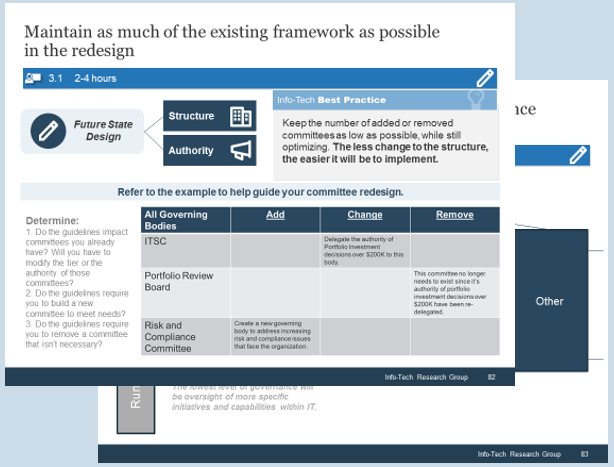 |
Redesign the Governance Structure
Identify committees that need to be added, ones that must be changed, and the no-longer-needed governing bodies in an optimized and streamlined structure. Draw it out in the governance structure map. |
3.2 |
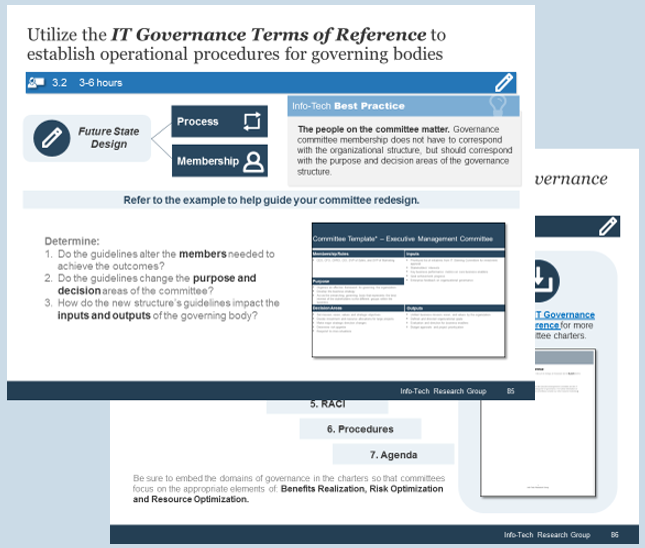 |
Redesign the Governing Bodies
Use the IT Governance Terms of Reference and the Committee Template to build a committee profile for each governing body identified. Use these activities to build out and establish the processes of the modified governing groups. |
Improve IT Governance to Drive Business Results
PHASE 4
Implement Governance Redesign
Phase 4 outline
![]() Call 1-888-670-8889 or email GuidedImplementations@InfoTech.com for more information.
Call 1-888-670-8889 or email GuidedImplementations@InfoTech.com for more information.
Complete these steps on your own, or call us to complete a guided implementation. A guided implementation is a series of 2-3 advisory calls that help you execute each phase of a project. They are included in most advisory memberships.
Guided Implementation 4: Implement Governance Redesign
Proposed Time to Completion: 2-3 weeks
| Step 4.1: Identify Steps for Implementation | Step 4.2: Finalized Implementation Plan |
Start with an analyst kick-off call:
|
Review findings with analyst:
|
Then complete these activities…
|
Then complete these activities…
|
With these tools & templates:
|
With these tools & templates:
|
Phase 4: Implement Governance Redesign
| 1 | 2 | 3 | 4 |
| Align IT With the Business Context | Assess the Current Governance Framework | Redesign the Governance Framework | Implement Governance Redesign |
Activities:
- 4.1 Identify Next Steps for the Redesign
- 4.2 Establish a Communication Plan
- 4.3 Lead the Executive Presentation
Outcomes:
- Rationalize steps in the Implementation Plan tool.
- Construct an executive presentation to facilitate transparency for the governing framework.
Anticipate and overcome implementation obstacles for the redesign
Often high-level organizational changes create challenges. We will help you break down the barriers to optimal IT governance by addressing key obstacles.
Key Obstacles |
Solutions |
| Identifying Steps | The prioritization must be driven by the common view of what is important for the organization to succeed. Prioritize the IT governance next steps according to the value they are anticipated to provide to the business. |
| Communicating the Redesign | The redesign of IT governance will bring impactful changes to diverse stakeholders across the organization. This phase will help you plan communication strategies for the different stakeholders. |
Info-Tech Insight
Don’t overlook the politics and culture of your organization while redesigning your governance framework.
Create an implementation roadmap to organize a plan for the redesign
![]() 4A Create an implementation and communication plan
4A Create an implementation and communication plan
INSTRUCTIONS
- Identify Tasks
Decide on the order of tasks for your implementation plan. Consider the dependencies of actions and plan the sequence accordingly. - Determine Communication Method
Identify the most appropriate and impactful method of communicating at each milestone identified in step 1.
Download the IT Governance Implementation Plan to organize your customized implementation and communication plan.
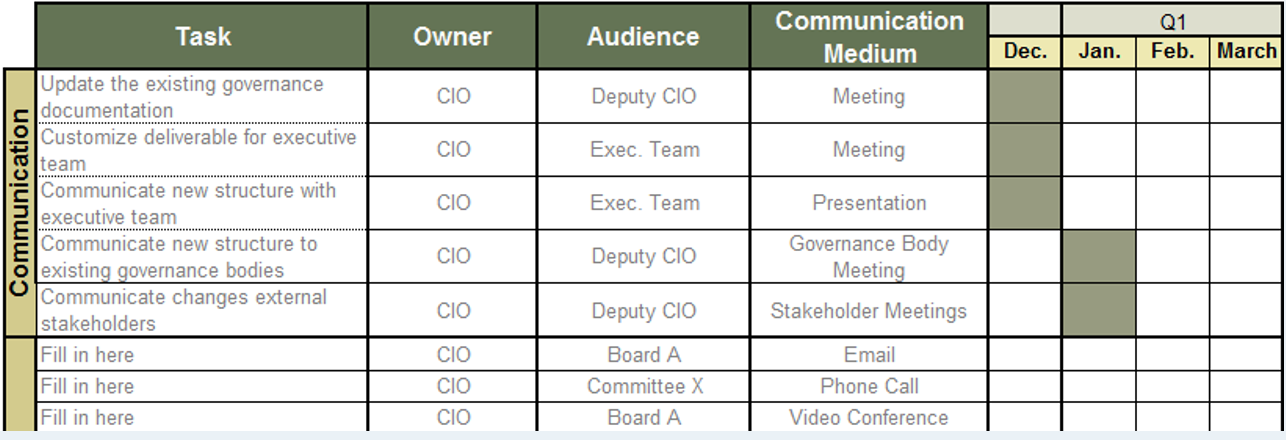
Outline next steps for governance redesign
![]() 4.1
4.1
INPUT: Tasks Identified in the Future State Design
OUTPUT: Identified Tasks for Implementation as Well as the Audience
Materials: N/A
Participants: IT Governance Redesign Owner
INSTRUCTIONS
Keep these questions in mind as you analyze and assess what steps to take first in the redesign implementation.
- What needs to happen?
Use the identified changes from the redesign as your guiding list of tasks that need to occur. If they are larger tasks, break them down into smaller parts to make the milestones more achievable. - What are the dependencies?
Throughout the implementation of the redesign, certain tasks will need to occur to enable other tasks to be performed. Make sure to clearly identify what dependencies exist in the implementation process and clearly identify the order of the tasks. - Who do the changes impact?
Consider the groups and individuals that will be impacted by changes to the governance framework. This includes key business stakeholders, IT leaders, members of governing boards, and anyone who provides an input or requires an output from one of the committees.
Use a big-bang approach to implement the IT governance redesign
While there are other methods to implementing change, the big-bang approach is the most effective for governance redesign and will maintain the momentum of the change as well as the support needed to make it successful.
Phased |
Parallel |
Big Bang |
Implementation of redesign occurs in steps over a significant period of time. 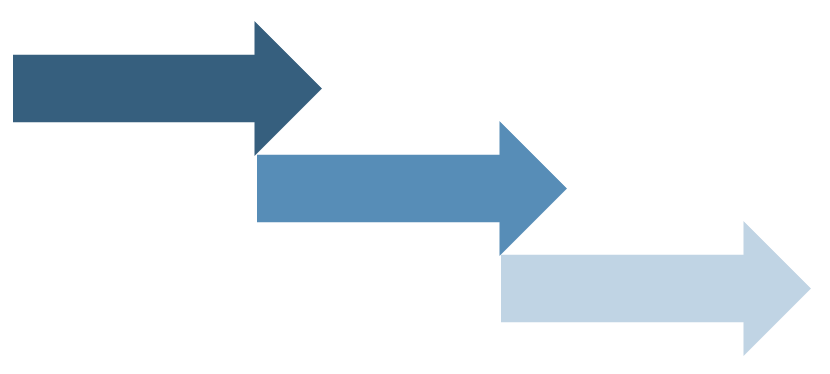 |
Components of the redesign are brought into the governance framework, while maintaining some of the old components. 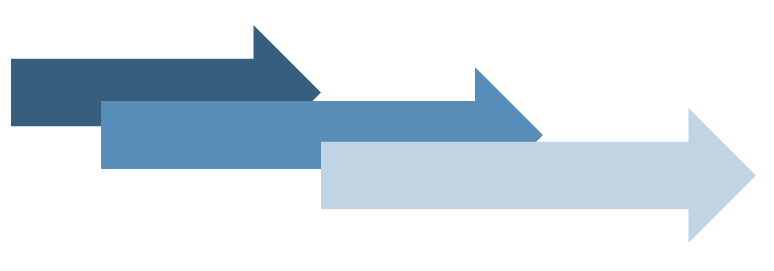 |
Implementation of redesign occurs all at once. This requires significant preparation. 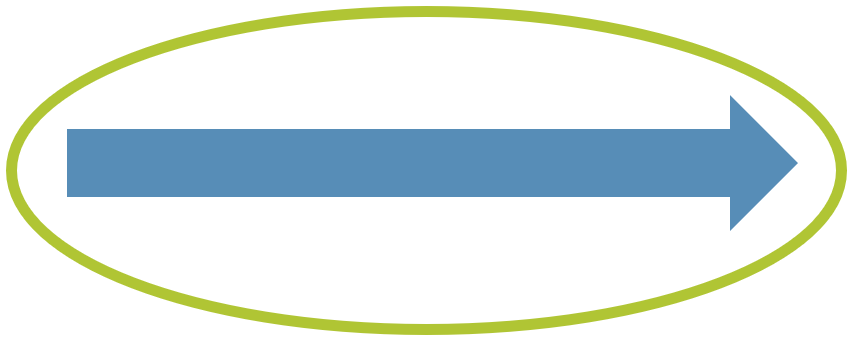 |
|
|
|
Determine the most effective and impactful communication mediums for relevant stakeholders
![]() 4.2 1 hour
4.2 1 hour
INSTRUCTIONS
- Consider the Individual or Group
Consider the group and individuals identified in step 4.1. Determine the most appropriate mechanism for communicating with that person or group. Keep in mind: If they are local, how much influence they have and if they are already engaged in the redesign process. - Consider the Message
The type of message that you are communicating will vary in impact and importance depending on the task. Make sure that the communication medium reflects your message. Keep in mind: If the you are communicating an important or more personal issue, the medium should be more personal as well.

Communicate the changes that result from the redesign
Plan the message first, then deliver it to your stakeholders through the most appropriate medium to avoid message avoidance or confusion.
Communication Medium
Face-to-Face Communication
Face-to-face communication helps to ensure that the audience is receiving and understanding a clear message, and allows them to voice their concerns and clarify any confusion or questions.
- Use one-on-one meetings for key stakeholders and large organizational meetings to introduce large changes in the redesign.
Emails
Use email to communicate information to broad audiences. In addition, use email as the mass feedback mechanism.
- Use email to follow up on meetings, or to invite people to next ones, but not as the sole medium of communication.
Internal Website or Drive
Use an internal website or drive as an information repository.
- Store meeting minutes, policies, procedures, terms of reference, and feedback online to ensure transparency.
Message Delivery
- Plan Your Message
Emphasize what the audience really needs to know and how the change will impact them. - Test Your Message
If possible, test your communications with a small audience (2-3 people) first to get feedback and adjust messages before delivering them more broadly. - Deliver and Repeat Your Message
“Tell them what you’re going to tell them, then tell them, then tell them what you told them.” - Gather Feedback and Evaluate Communications
Evaluate the effectiveness of the communications (through surveys, stakeholder interviews, or metrics) to ensure the message was delivered and received successfully and communication goals were met.
Construct an executive presentation to facilitate transparency for the governing framework
![]() 4B Present the redesign to the key business stakeholders
4B Present the redesign to the key business stakeholders
INSTRUCTIONS
- Identify Stakeholders
Determine which business stakeholders have been the most involved in the redesign process. - Customize Presentation
Use the deliverables that you have built throughout this redesign to communicate the changes to the structure, authority, processes, and memberships in the governance framework. - Present to Executives
Present the executive presentation to the key business stakeholders who have been involved in the redesign process.
Info-Tech best Practice
Use the Executive Presentation customizable deliverable to lead a boardroom-quality presentation outlining the process and outcomes of the IT governance redesign.
Present the executive presentation
![]() 4.3 1 hour
4.3 1 hour
INSTRUCTIONS
- Input SoBC Outcomes
Input the outcomes of the SoBC. Specify the state of the business you have identified through the process of Phase 1. - Input Current State Framework and Guidelines
Input the outcomes of the current state assessment. Explain the process you used to identify the current governance framework and how you determined the strengths, weaknesses, and guidelines. - Input Redesigned Governance Framework
Input the governance redesign outcomes. Explain the process you used to modify and reconstruct the governance framework to drive optimal business results. Show the new structure and committee profiles.
Use the Redesign IT Governance to Drive Optimal Business Results Executive Presentation Template for more information.
Implement the governance redesign to optimize governance and, in turn, business results
CASE STUDY
Industry: Healthcare
Source: Info-Tech
Challenge
Members of the project management group and in the larger SDLC process identified a lack of clarity on how to best govern active projects and initiatives that were moving through the governance process during the changes to the governance framework.
These projects had already begun under the old frameworks and applying the redesigned governance framework would lead to work duplication and wasted time.
Solution
The organization decided that instead of applying the redesign to all initiatives across the organization, it would only be applied to new initiatives and ones that were still working within the first part of the “gating” process, where revised intake information could still be provided.
Active initiatives that fell into the grandfathered category were identified and could proceed based on the old process. Yet, those that did not receive this status were provided carry-over lead time to revise their documentation during the changes.
Results
The implementation plan and timeframes were approved and an official change-over date identified.
A communication plan was provided, including the grandfathered approach to be used with in-flight initiatives.
A review cycle was also established for three months after launch to ensure the process was working as expected and would be repeated annually.
The revised process improved the cycle time by 30% and improved the ability of the organization to govern high-speed requests and decisions.
Summary of accomplishment
Insights
- IT governance requires business leadership.
Instead of IT managing and governing IT, engage business leaders to take responsibility for governing IT. - With great governance comes great responsibility.
Involve relevant business leaders, who will be impacted by IT outcomes, to share governing authority of IT. - Establish IT-business fusion.
In governance, alignment is not enough. Merge IT and the business through governance to ensure business success.
Knowledge Gained
- There must be an active understanding of the current and future state of the business for governance to address the changing needs of the business.
- Take a proactive approach to revising your governance framework. Understand why you are making decisions before actually making them.
- Keep the current and future goals in sight to build an optimized governance framework that maintains the minimum bar of oversight required.
Processes Optimized
- EDM01 – Establishing a Governance Framework
- Understanding the four elements of governance:
- Structure
- Authority
- Process
- Members
- Embedding the benefits realization criteria, risk optimization, and resource optimization in governance.
Deliverables Completed
- Statement of Business Context
- Current State Assessment of IT Governance
- Future State Design for IT Governance
- IT Governance Implementation Plan
If you want additional support, have our analysts guide you through this phase as part of an Info-Tech Workshop 
Book a workshop with our Info-Tech analysts:
 |
|
The following are sample activities that will be conducted by Info-Tech analysts with your team:
4.1 |
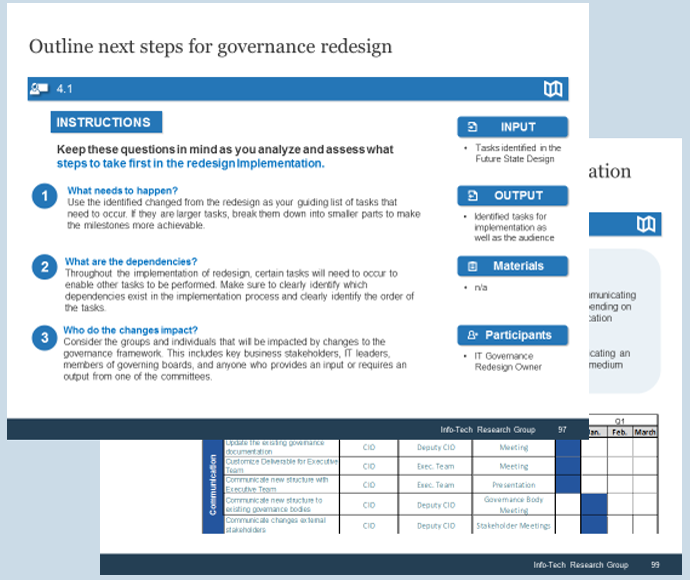 |
Build and Deploy the Implementation Plan
Construct a list of tasks and consider the individuals or groups that those tasks will impact when implementing the governance redesign. Ensure consistent and transparent communication for successful outcomes. |
4.3 |
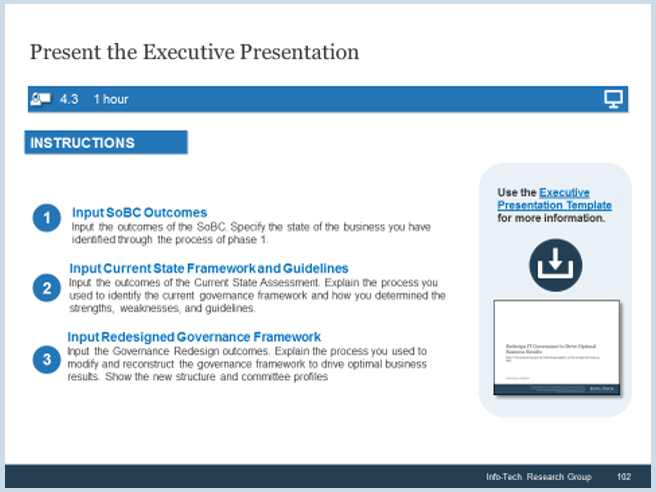 |
Build the Executive Presentation
Insert the state of business, current state, and future state design outcomes into a presentation to inform the key business stakeholders on the process and outcomes of the governance redesign. |
Research contributors and experts
Deborah Eyzaguirre, IT Business Relationship Manager, UNT System
Herbert Kraft, MIS Manager, Prairie Knights Casino
Roslyn Kaman, CFO, Miles Nadal JCC
Nicole Haggerty, Associate Professor of Information Systems, Ivey Business School
Chris Austin, CTO, Ivey Business School
Adriana Callerio, IT Director Performance Management, Molina Healthcare Inc.
Joe Evers, Consulting Principal, JcEvers Consulting Corp
Huw Morgan, IT Research Executive
Joy Thiele, Special Projects Manager, Dunns Creek Baptist Church
Rick Daoust, CIO, Cambrian College
Related Info-Tech Research
- Establish an Effective IT Steering Committee
Have the right people making the right decisions to drive IT success.
Bibliography
A.T. Kearney. “The 7 Habits of Highly Effective Governance.” A.T. Kearney, 2008. Web. Nov. 2016.
Bertolini, Phil. “The Transformational Effect of IT Governance.” Government Finance Review, Dec. 2012. Web. Nov. 2016.
CGI. “IT Governance and Managed Services – Creative a win-win relationship” CGI Group Inc., 2015. Web. Dec. 2016.
De Haes, Steven, and Wim Van Grembergen. “An Exploratory Study into the Design of an IT Governance Minimum Baseline through Delphi Research.” Communications of the Association for Information Systems: Vol. 22 , Article 24. 2008. Web. Nov. 2016.
Deloitte LLP. “The Role of Senior Leaders in IT Governance.” The Wall Street Journal, 22 Jun. 2015. Web. Oct. 2016.
Dragoon, Alice. “Four Governance Best Practices.” CIO From IDG, 15 Aug. 2003. Web. Dec. 2016.
du Preez, Gert. “Company Size Matters: Perspectives on IT Governance.” PricewaterhouseCoopers, Aug. 2011. Web. Nov. 2016.
Hagen, Christian, et. al. “Building a Capability-Driven IT Organization.” A.T. Kearney, Jun. 2011. Web. Nov. 2016.
Heller, Martha. “Five Best Practices for IT Governance.” CFO.com, 27 Aug. 2012. Web. Oct. 2016.
Hoch, Detlev, and Payan, Miguel. “Establishing Good IT Governance in the Public Sector.” McKinsey Dusseldorf, Mar. 2008. Web. Oct. 2016.
Horne, Andrew, and Brian Foster. “IT Governance Is Killing Innovation.” Harvard Business Review, 22 Aug. 2013. Web. Dec. 2016.
ISACA. “COBIT 5: Enabling Processes.” ISACA, 2012. Web. Oct. 2016.
IT Governance Institute. “An Executive View of IT Governance.” IT Governance Institute, in association with PricewaterhouseCoopers. 2009. Web. Nov. 2016.
Bibliography continued
IT Governance Institute. “IT Governance Roundtable: Defining IT Governance.” IT Governance Institute, 2009. Web. Nov. 2016.
Macgregor, Stuart. “The linchpin between Corporate Governance and IT Governance.” The Open Group’s EA Forum Johannesburg and Cape Town, Nov. 2013. Web. Nov. 2016.
Mallette, Debra. “Implementing IT Governance An Introduction.” ISACA San Francisco Chapter, 23 Sep. 2009. Web. Oct. 2016.
Massachusetts Institute of Technology. “IT Governance Introduction.” MIT Centre for Information System Research, 2016. Web. Nov. 2016.
Mueller, Lynn, et. al. “IBM IT Governance Approach – Business Performance through IT Execution.” IBM Redbooks, Feb. 2008. Web. Nov. 2016.
National Computing Centre. “IT Governance: Developing a successful governance strategy.” The National Computing Centre, Nov. 2005. Web. Oct. 2016.
Pittsburgh ISACA Chapter. “Practical Approach to COBIT 5.0.” Pittsburgh ISACA Chapter, 17 Sep. 2012. Web. Nov. 2016.
PricewaterhouseCoopers. “Great by governance: Improve IT performance and Value While Managing Risks.” PricewaterhouseCoopers, Nov. 2014. Web. Dec. 2016.
PricewaterhouseCoopers. “IT Governance in Practice: Insights from leading CIOs.” PricewaterhouseCoopers, 2006. Web. Nov. 2016.
Routh, Richard L. “IT Governance Part 1 of 2.” Online video clip. YouTube. The Institute of CIO Excellence, 01 Aug. 2012. Web. Nov. 2016.
Salleh, Noor Akma Mohd, et. al. “IT Governance in Airline Industry: A Multiple Case Study.” International Journal of Digital Society, Dec. 2010. Web. Nov. 2016.
Bibliography continued
Speckert, Thomas, et. al. “IT Governance in Organizations Facing Decentralization – Case Study in Higher Education.” Department of Computer and Systems Sciences. Stockholm University, 2014. Web. Nov. 2016.
Thorp, John. The Information Paradox—Realizing the Business Benefits of Information Technology. Revised Edition, McGraw Hill, 2003 (written jointly with Fujitsu).
Vandervost, Guido, et. al. “IT Governance for the CxO.” Deloitte, Nov. 2013. Web. Nov. 2016.
Weill, Peter, and Jeanne W. Ross. “IT Governance: How Top Performers Manage IT Decision Rights for Superior Results.” Boston: Harvard Business School, 2004. Print. Oct. 2016.
Wong, Daron, et. al. “IT Governance in Oil and Gas: CIO Roundtable, Priorities for Surviving and Thriving in Lean Times.” Online video clip. YouTube. IT Media Group, Jun. 2016. Web. Nov. 2016.
Buying Options
Improve IT Governance to Drive Business Results
Client rating
Cost Savings
Days Saved
IT Risk Management · IT Leadership & Strategy implementation · Operational Management · Service Delivery · Organizational Management · Process Improvements · ITIL, CORM, Agile · Cost Control · Business Process Analysis · Technology Development · Project Implementation · International Coordination · In & Outsourcing · Customer Care · Multilingual: Dutch, English, French, German, Japanese · Entrepreneur
Tymans Group is a brand by Gert Taeymans BV
Gert Taeymans bv
Europe: Koning Albertstraat 136, 2070 Burcht, Belgium — VAT No: BE0685.974.694 — phone: +32 (0) 468.142.754
USA: 4023 KENNETT PIKE, SUITE 751, GREENVILLE, DE 19807 — Phone: 1-917-473-8669
Copyright 2017-2022 Gert Taeymans BV